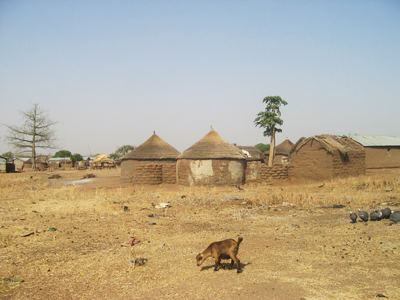 |
|
Fig. 1. Yikpabongo |
Franz Kröger
The Komaland Terracottas - Description, Classification and Analysis
Note: The complete essay on this subject (in German) can be found in the following publication:
Hans Scheutz, Die vergessene Kultur / The forgotten Culure - Terrakotten aus Nordghana / Terracottas from North Ghana
248 pages; ISBN: 978-3-643-50780-8;
LIT Verlag: Berlin Münster Wien Zürich LondoneMail:
lit@lit-verlag.de Order requests to vertrieb@lit-verlag.de
Abstract
 |
|
Fig. 1. Yikpabongo |
In 1985, when the archaeologist James Anquandah (University of Ghana, Legon) started his first excavations in Yikpabongo (Komaland), a new West African terracotta culture started to attract the attention of archaeologists, historians and art-lovers. Although the new finds can be regarded as equivalent to those of the Nok culture (Nigeria) and the Mali Inland Delta (Djenné and Bankoni), the Komaland figurines are, in fact, completely independent pieces of art. Their creators probably intended to produce objects suitable for their religious activities, but today we still do not know the details concerning their meaning, function and cultural context.
Discovery and Archaeological Excavations
The first recent contact with the old terracottas took place in the 1960s or 1970s when the people of Yikpabongo were digging for clay as a building material. They called these artefacts Kronkrombali which means “children of an ancient time”.
It has been stated that the author (F.K.) has contributed significantly to the scientific discovery since he was the first to publish about it (1982), the first to carry out a TL-dating (1984) and the person who prompted the first excavations by J. Anquandah (1984/85).
After an inactive period of nearly twenty years, B. Kankpeyeng (Legon), temporarily assisted by T. Insoll (Manchester), S.N. Nkumbaan (Legon), N. Swanepoel (Pretoria) and students from Legon, has begun to once again carry out excavations.
Who Were the Creators of the Terracottas?
The material culture of several ancient civilisations and peoples shows striking similarities to the Komaland terracottas, especially with regard to the objects represented on their bodies. For chronological and stylistic reasons, it is not very probable that the creators of the old Akan terracottas exerted any influence on the Komaland culture. Some cultural elements of the Mali Inland Delta (e.g. arm daggers, particular scarifications on the temples and the belly and two sacrificial bowls in front of female figurines) appear in both cultures.
In his 1998 publication, Anquandah describes many similar elements between the Bulsa and the old Komaland cultures. However, these similarities also appear in several other ethnic groups. The parallels between the Lobi of Burkina Faso and the Komaland culture (for example their coned figurines) are also very striking.
The Gan as Potential Creators
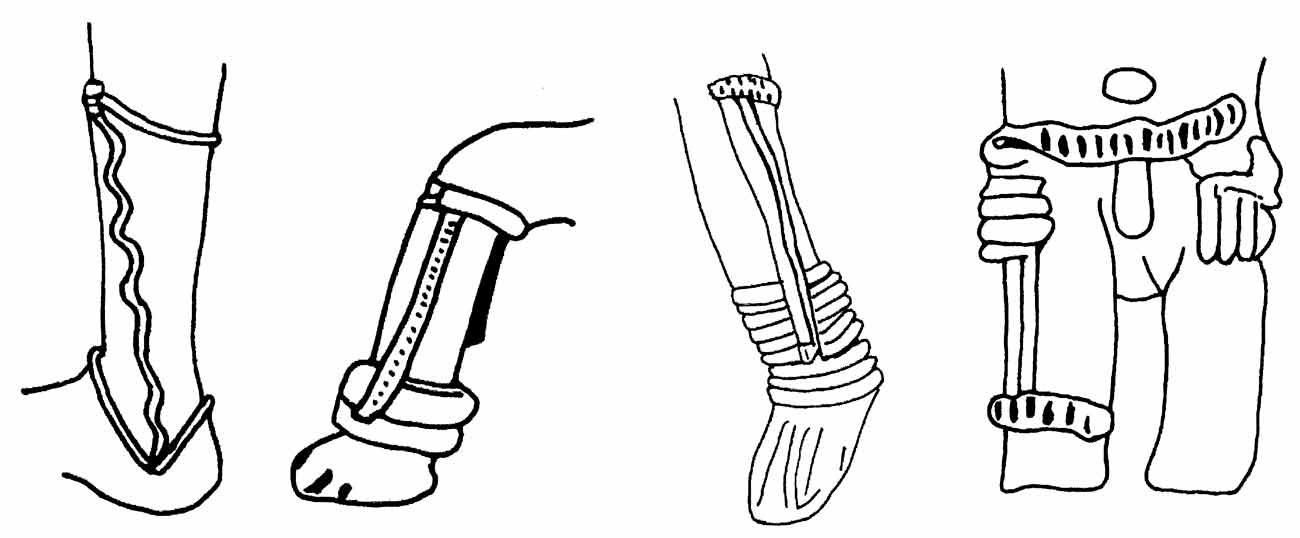 |
|
Fig. 2-5. Left: Leg-amulet of the Lobi (source: A. Fisher 1984: 129); Fig. 3-5: Komaland leg-amulets |
Among all the theories about other cultures having exerted influence on the Komaland terracottas, the hypothesis that the Gan or groups related to them were the creators of the Komaland culture is most probable. Several parallels such as a very particular leg amulet (Fig. 2-5), a circular breast-pendant and, according to Père (2004), also coned terracotta figures may support this assumption.
There might be a correlation between the Komaland Janus figurines with triangular heads and the Gan snake depictions. Moreover, some janiform terracotta disks resemble the Gan representations of multiple bronze snake heads arranged in a circle (Fig. 11-12).
More significantly, there are correspondences between the death cults of the two cultures. In 2007 and 2010, Kankpeyeng found single human skulls in his Yikpabongo excavations. This burial type corresponds to the former Gan custom of removing the heads of kings and albinos from their bodies and burying them separately.
 |
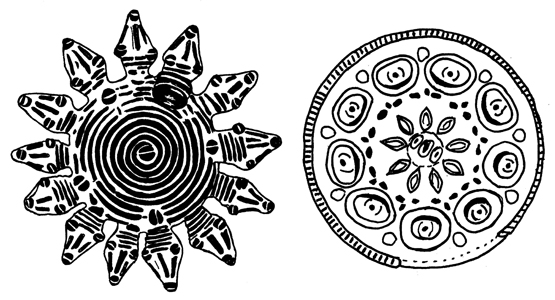 |
|
Fig. 6-11. Left: Bronze-snake heads of a Gan sculpture. Fig. 7-9: Komaland Janus figurines. Fig. 10. Bronze disc of the Gan. Fig. 11: Terracotta disc of the Komaland culture |
|
According to Père (2004) and Bognolo (2010), the Gan originate from an area near Accra (Ghana). On their migration to the north, they stayed in many towns located in present-day northern Ghana, e.g. Bole, Larabanga, Wa, Gambaga (Fig. 13). They preferred to settle in areas with gold deposits (Père 2004), and Komaland, with three goldmines in present times, might have been attractive for them, although such a stay is not mentioned in oral traditions.
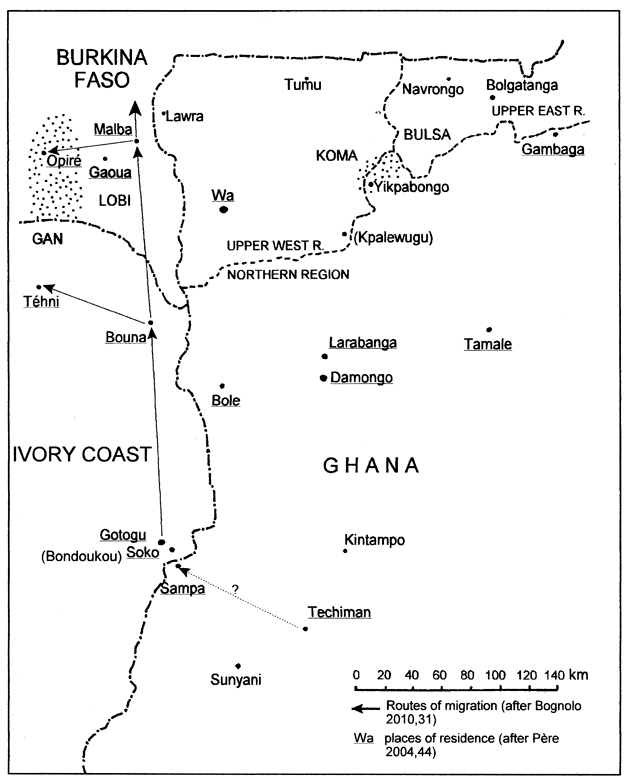 |
|
Fig. 12. Migration history of the Gan (according to Père 2004 and Bognolo 2012) |
Dating
The first thermoluminescence (TL) datings of Yikpabongo terracottas yielded an age range of between 400 and 800 years old. More recently, new radiocarbon and TL-datings were commissioned by Kankpeyeng. Their results indicated that some objects of the excavations were created between approximately 500 and 1100 AD (Kankpeyeng et al. 2011: 209), and thus the beginning of the Komaland culture may have started in that period.
Coned Figurines
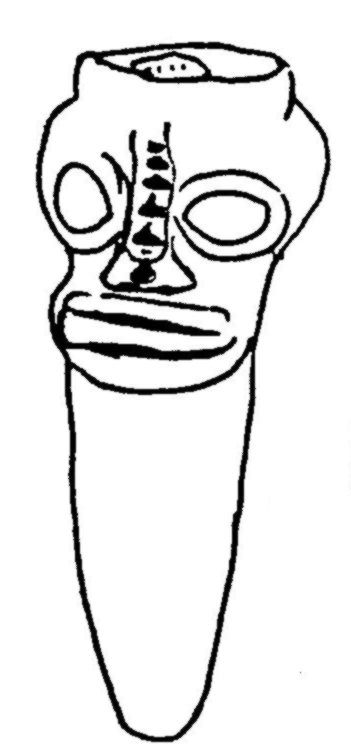 |
|
Fig. 13 |
There is general agreement that the coned lower ends of these types of figurines were inserted into the ground or a mud shrine and that the concave skull with a deep hole or slit was the place where these figurines received their libations (Fig. 13). The deep holes or slits, usually surrounded by a rim of clay, are often interpreted as cowries or vaginas.
Like other Komaland terracottas, the coned figurines are usually found in the mound without a recognizable arrangement, and most of them are fragmented. Perhaps they were ritually broken, as is done with other ceramic objects at Bulsa funerals.
Conical terracotta objects without faces and limbs are interpreted here as stylized and simplified anthropomorphic figures since they also possess the concave skull with a hole and may have applications of female breasts (Fig. 15 and 18) or a penis . Multiplying the number of head-bowls (by two, three or four times) is quite common (Fig. 16-19). Some other specimens of coned terracottas have a shoulder-like widening under the head, usually with incised patterns (Fig. 20-22). This has been interpreted as the hood of a snake. If Gan groups were the creators of the Komaland figurines, this presumption gains even more credibility since the snake-cult played an important role in the Gan religion.
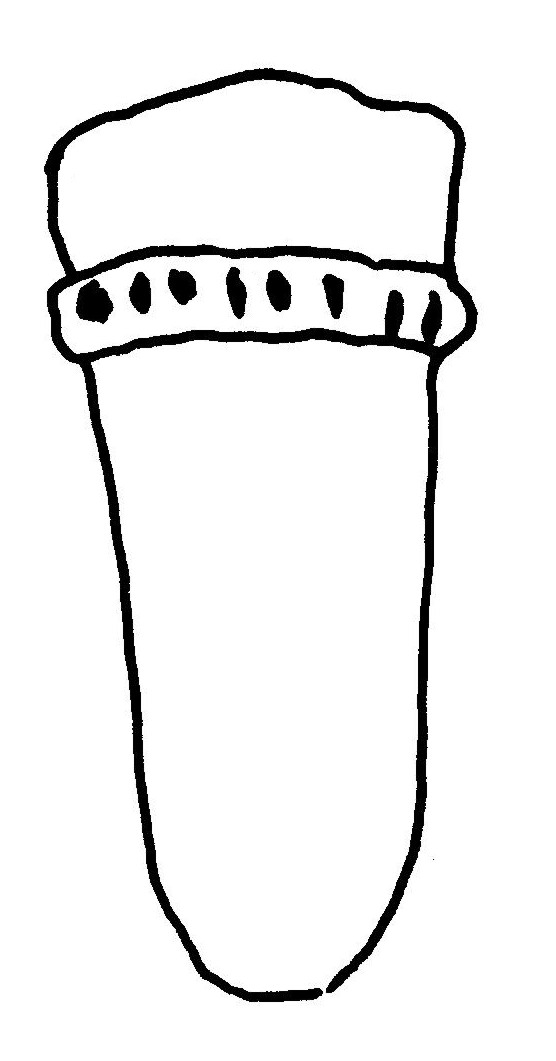 |
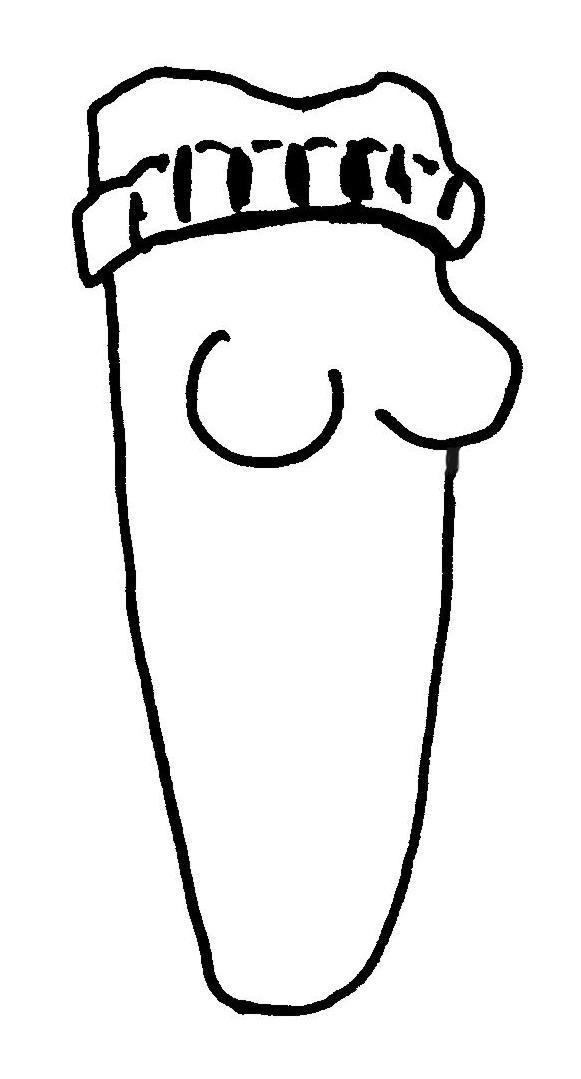 |
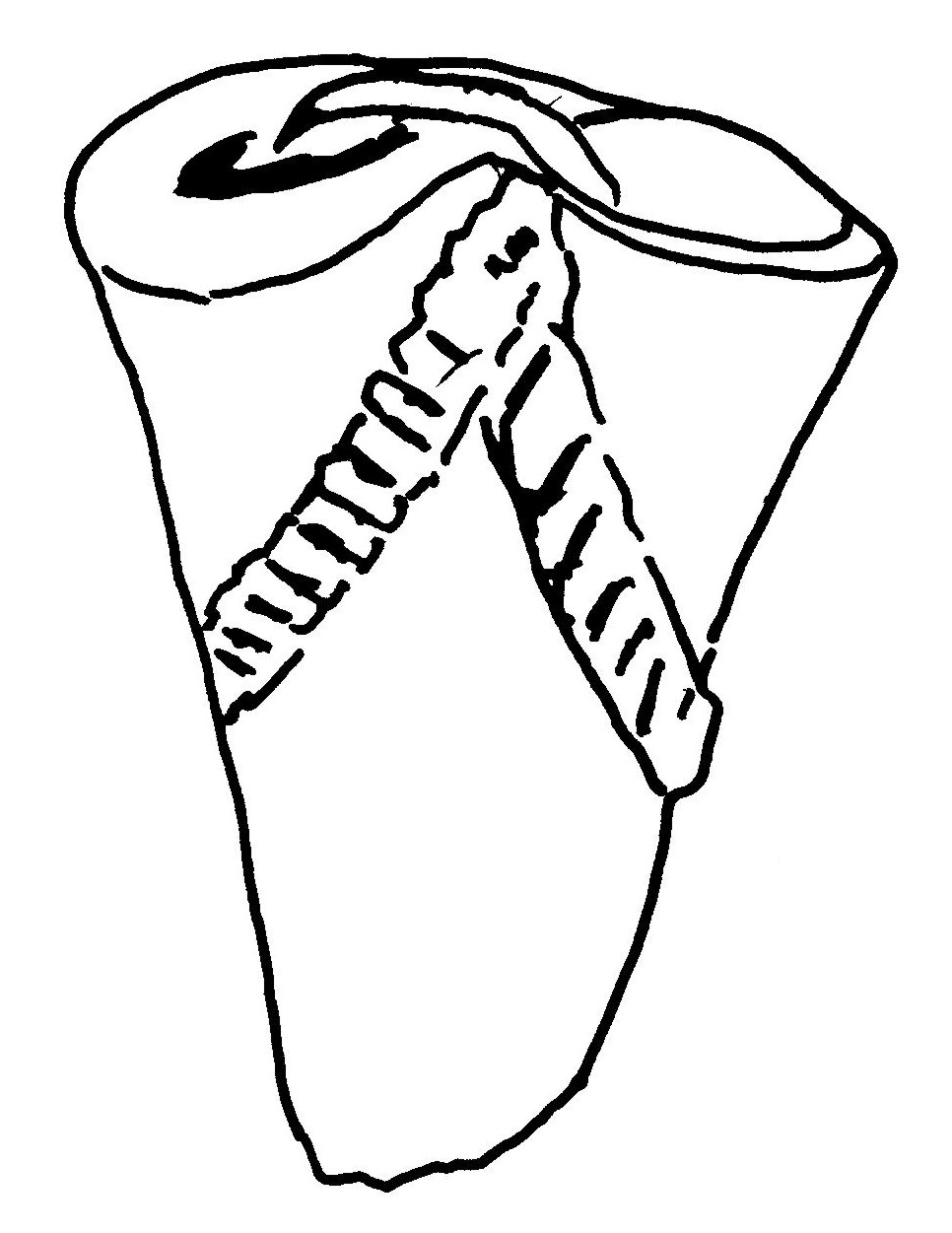 |
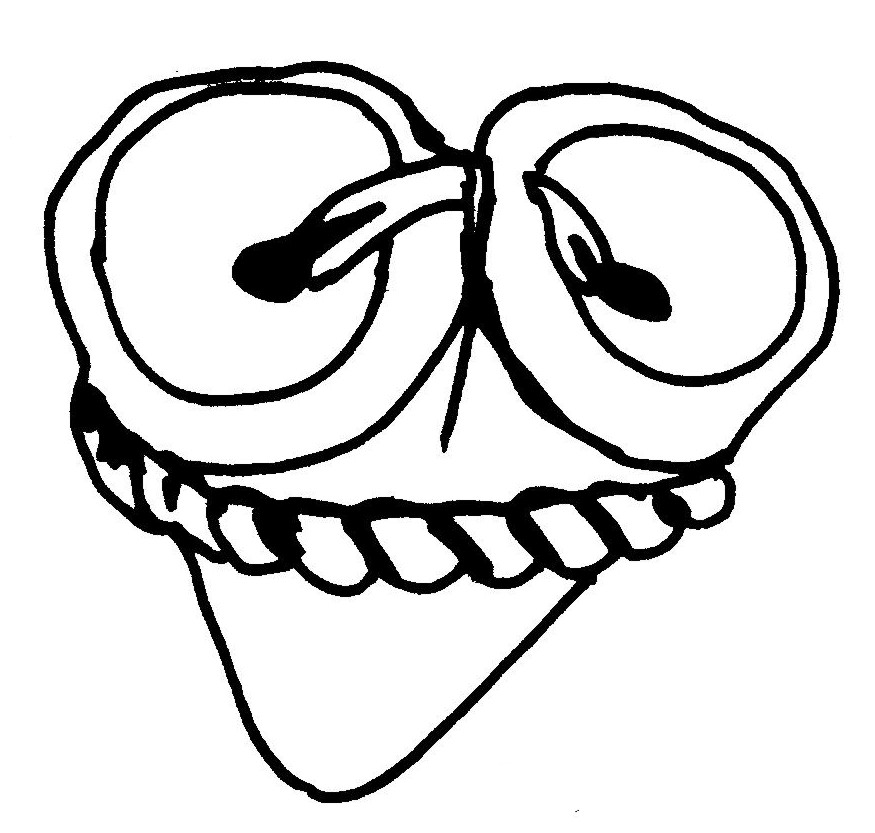 |
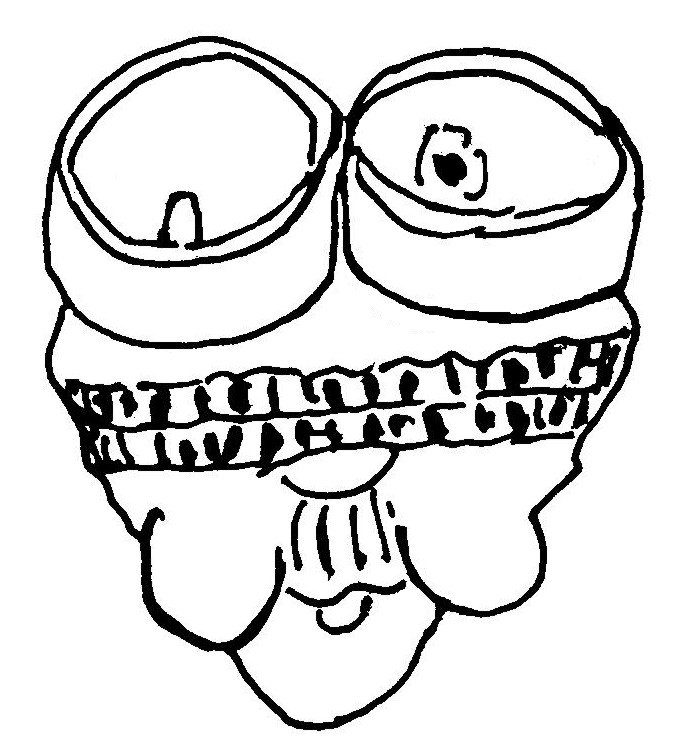 |
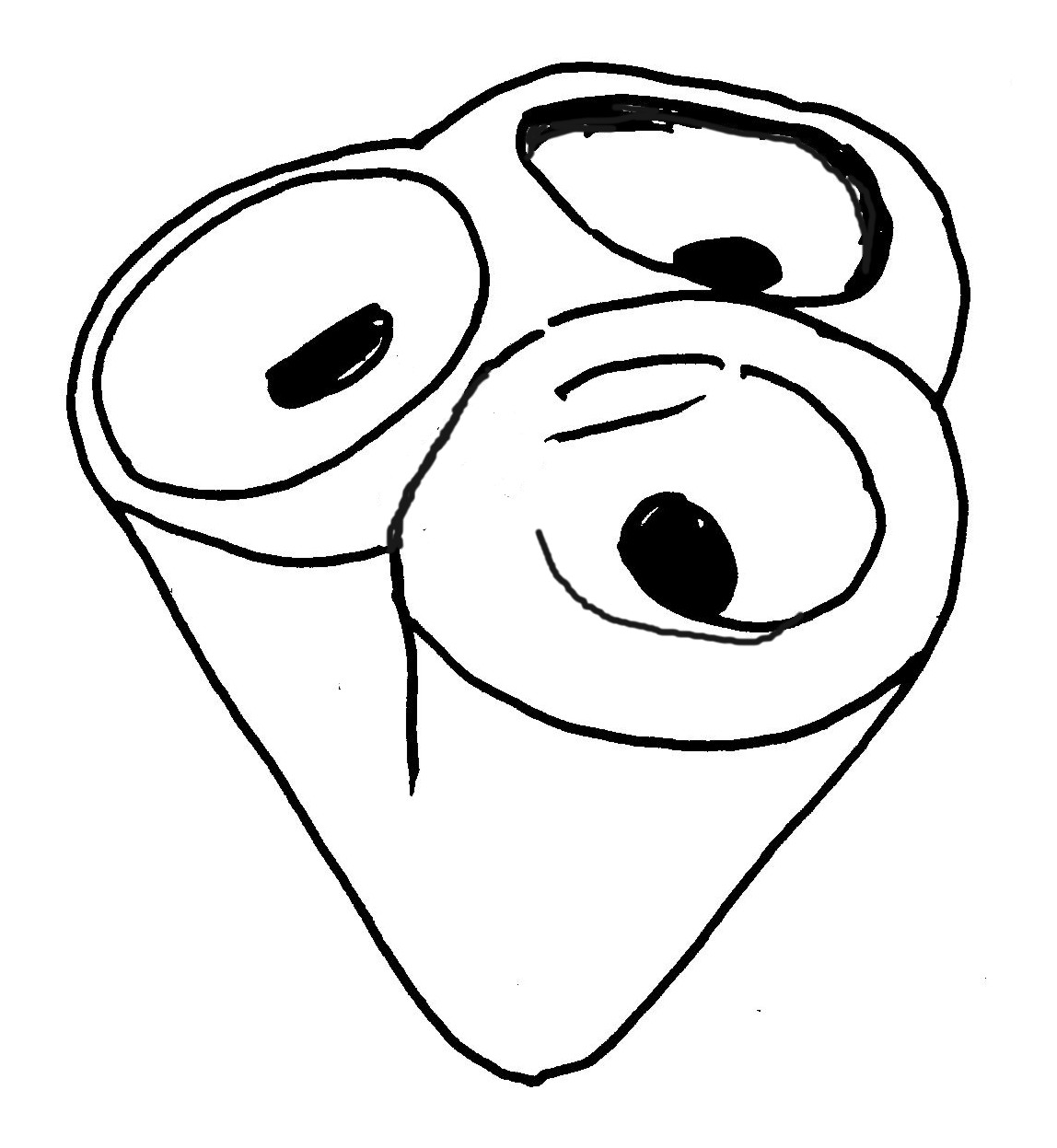 |
| Fig. 14 | Fig. 15 | Fig. 16 | Fig. 17 | Fig. 18 | Fig. 19 |
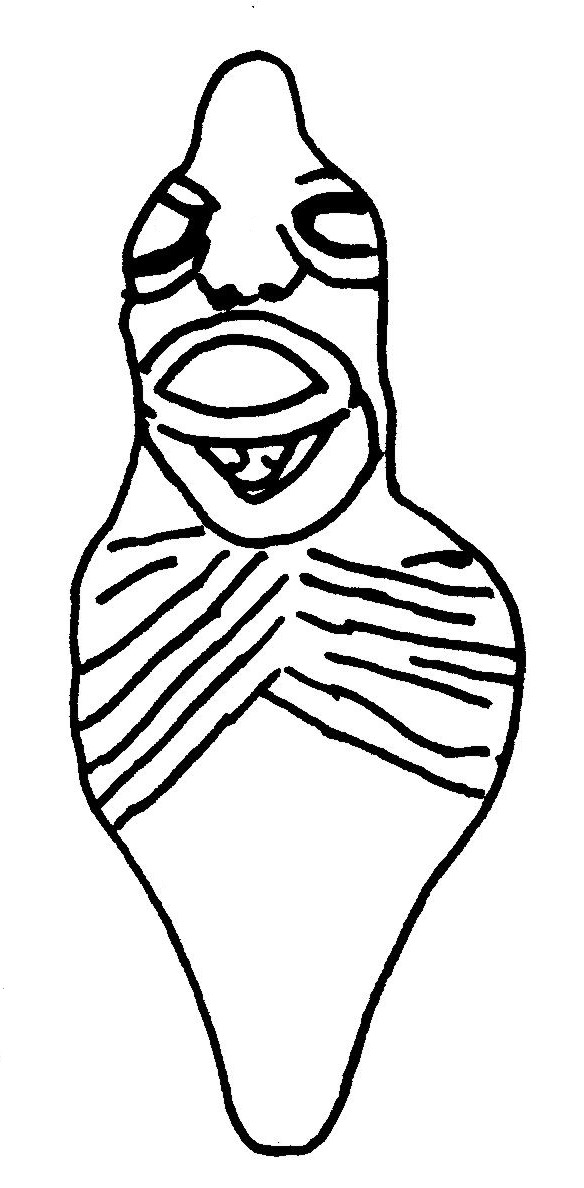 |
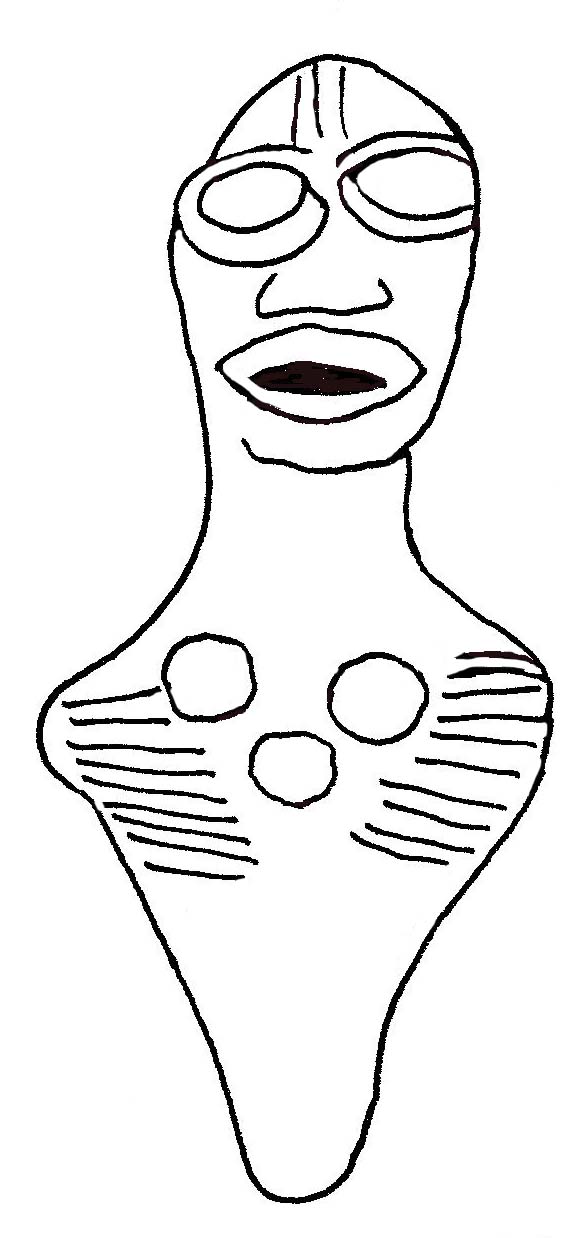 |
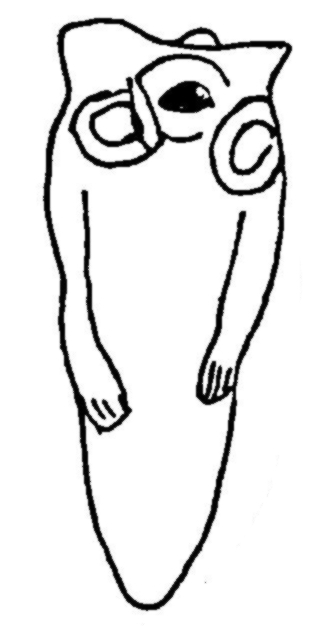 |
| Fig. 20 | Fig. 21 | Fig. 22 |
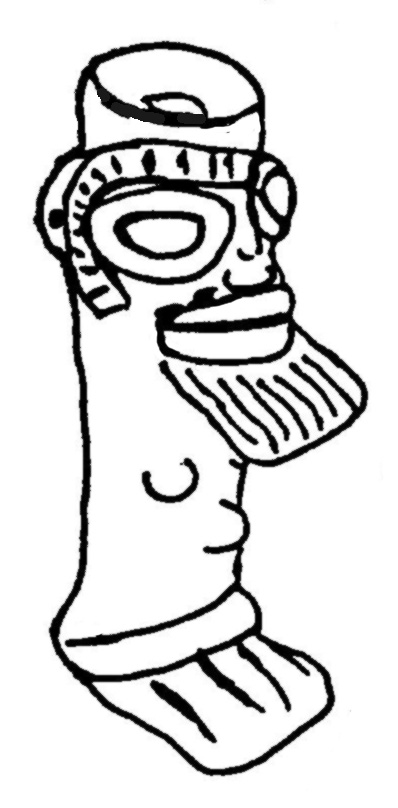 |
| Fig. 23 |
One-footed Figurines
One-footed figurines with concave heads and columnar trunks resemble the coned figurines, but in contrast to them, their flat bases consist of the sole of one single foot (Fig. 23). We do not know anything about the meaning of this type of terracotta, however. Possibly they represent mythical entities or bush spirits.
Whole-body Figurines
This large group may be divided into three subtypes: 1. Figurines, standing or seated, with a concave skull and long arms (Fig. 24), 2. Figurines, standing or seated, with rounded heads and long arms (Fig. 25), 3. Standing figurines with rounded heads and very short arms resembling wings or fins (Fig. 26).
Usually the backs of the whole-body figurines are lacking in any details. Necklaces, waist-strings and sashes, for example, are sometimes not continued on the back. This leads us to believe that only the front sides of these figurines were looked at and that perhaps they were placed in front of a wall or a shrine.
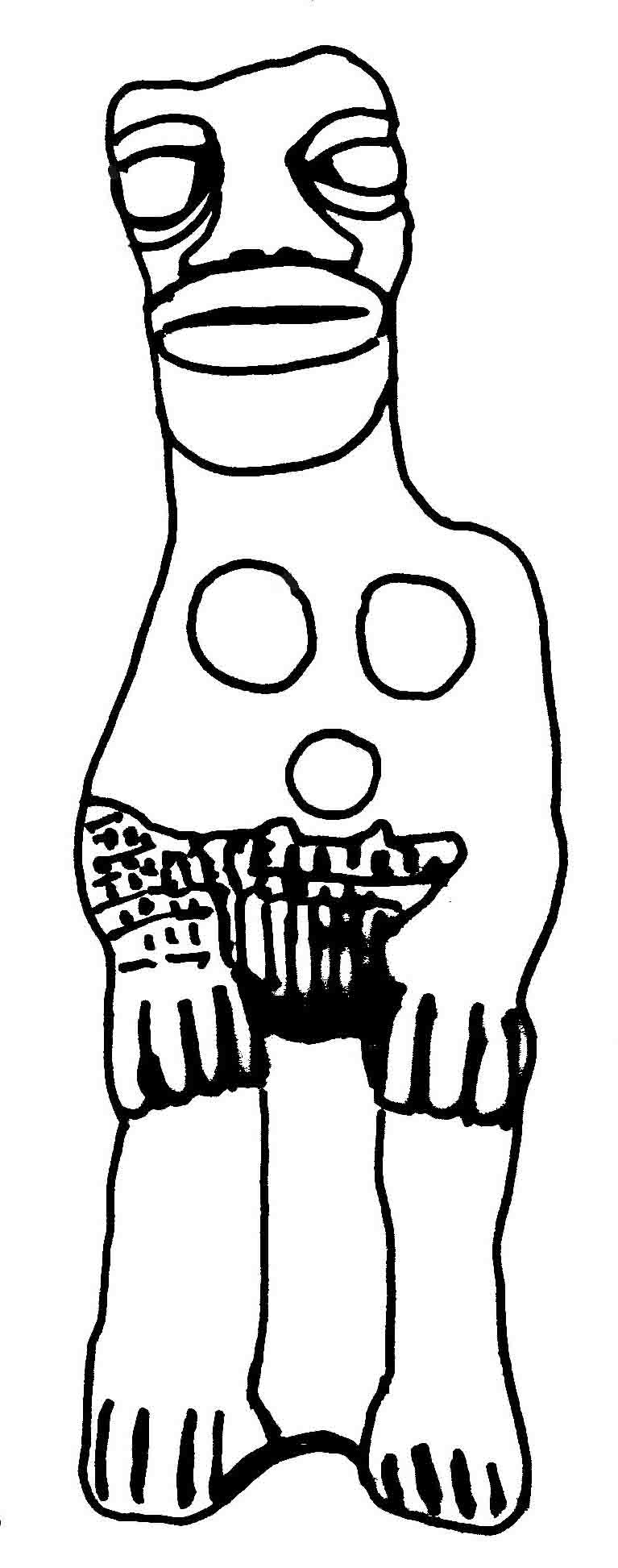 |
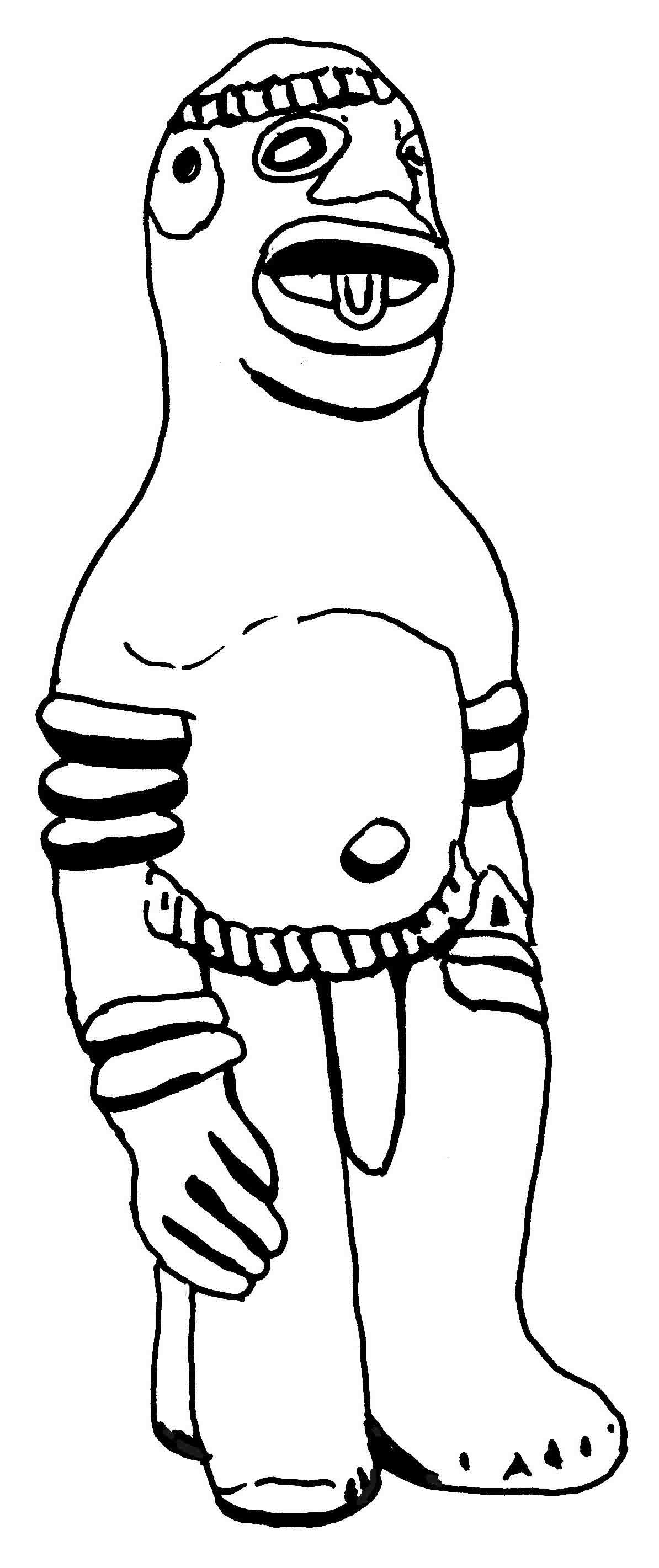 |
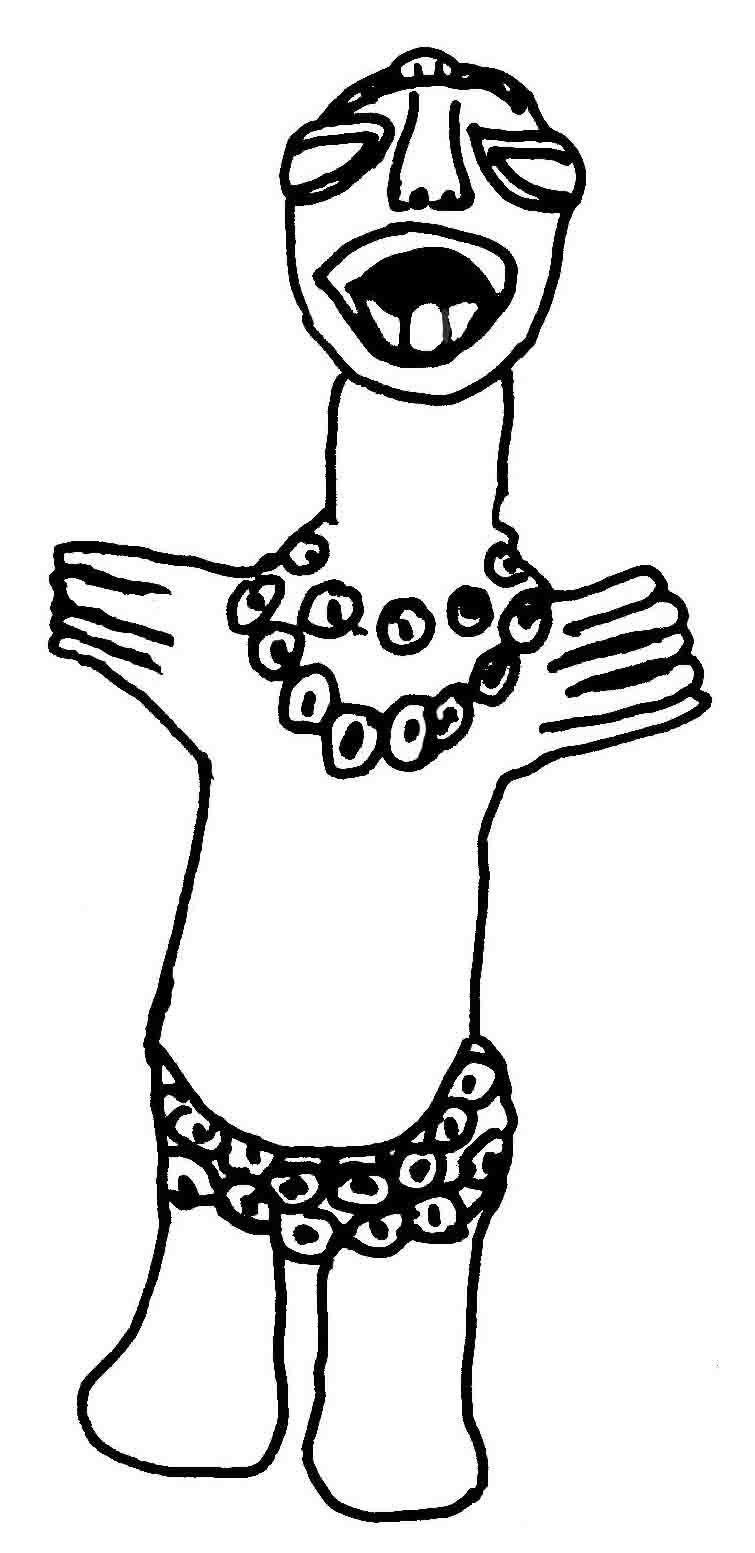 |
| Fig. 24 | Fig. 25 | Fig. 26 |
Mother and Child
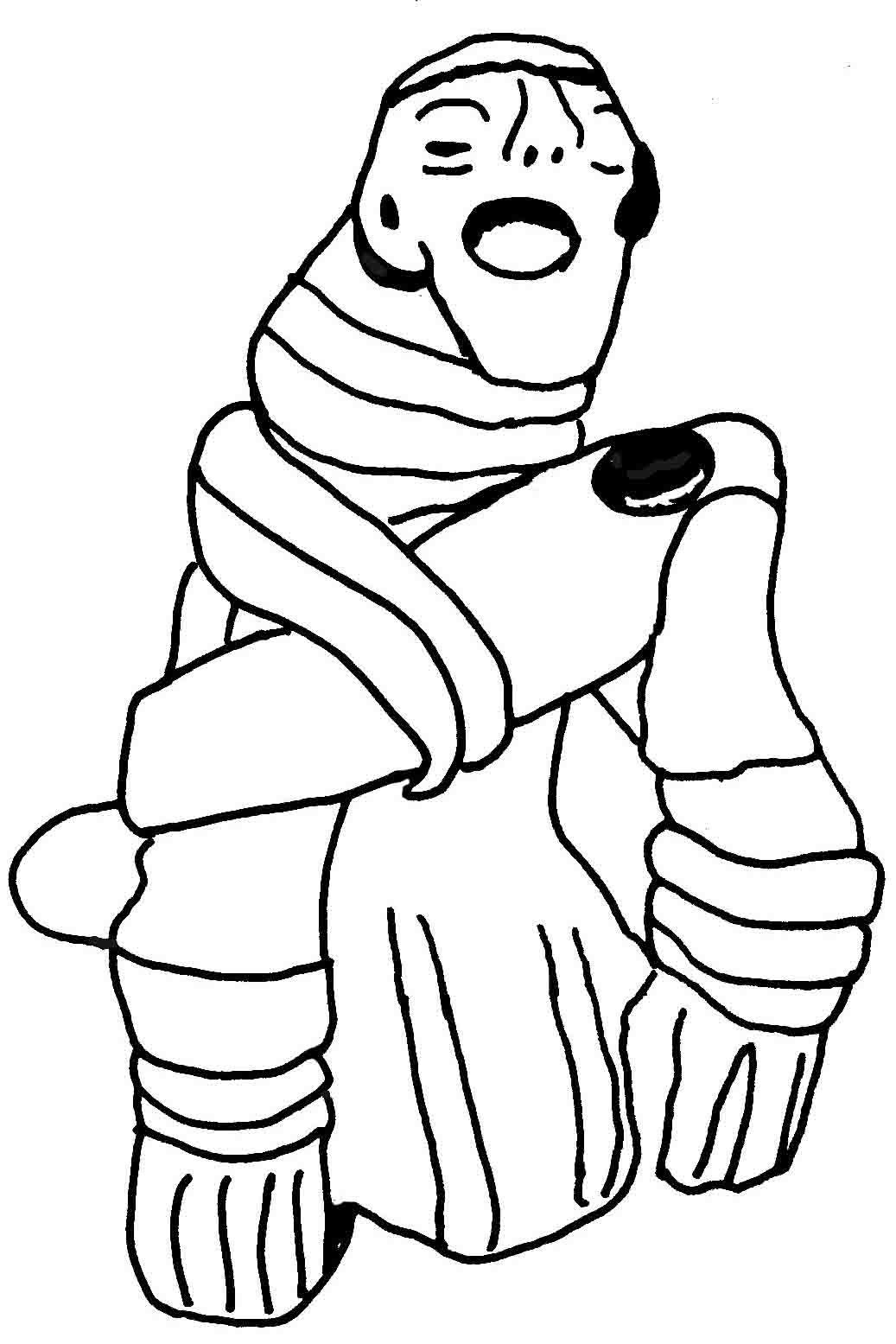 |
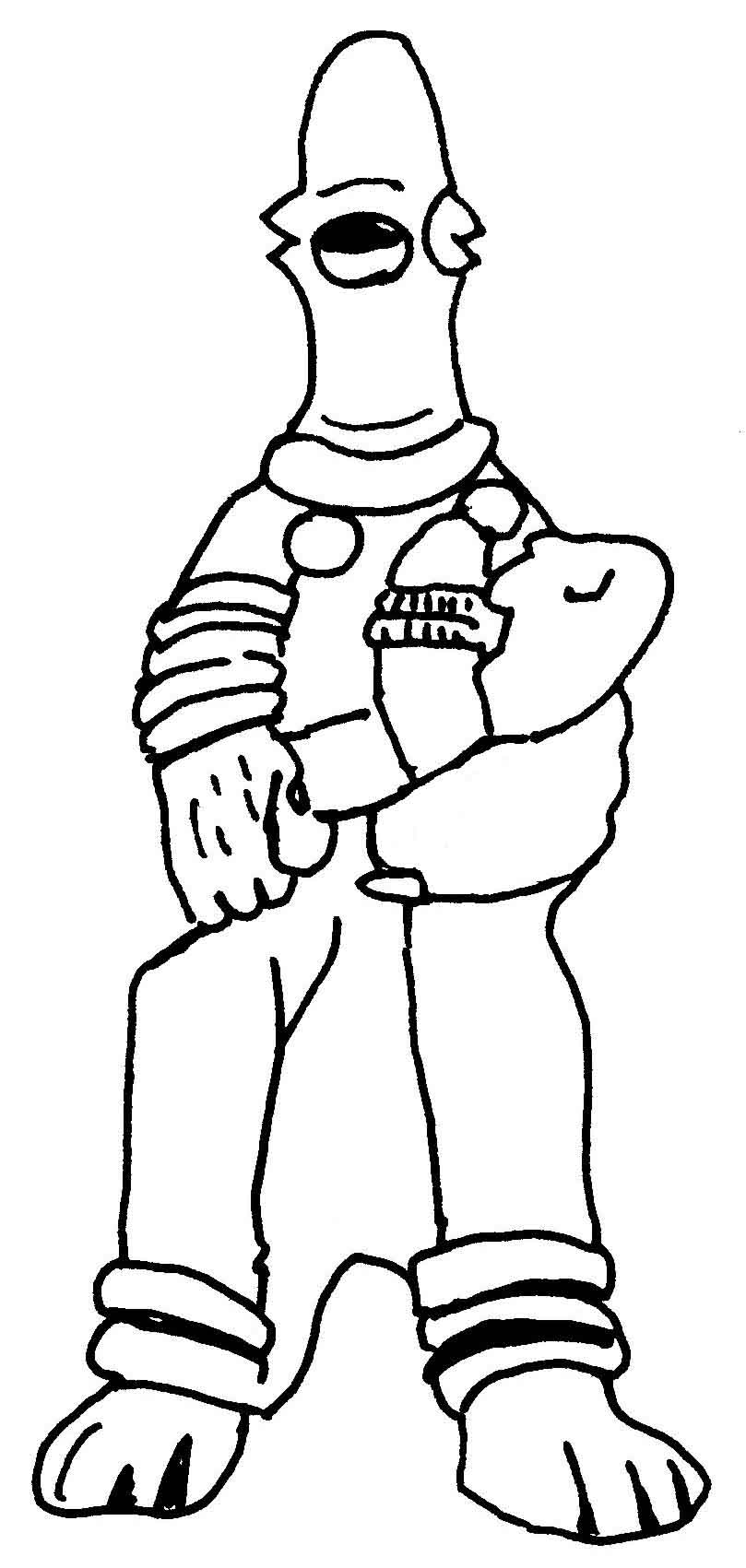 |
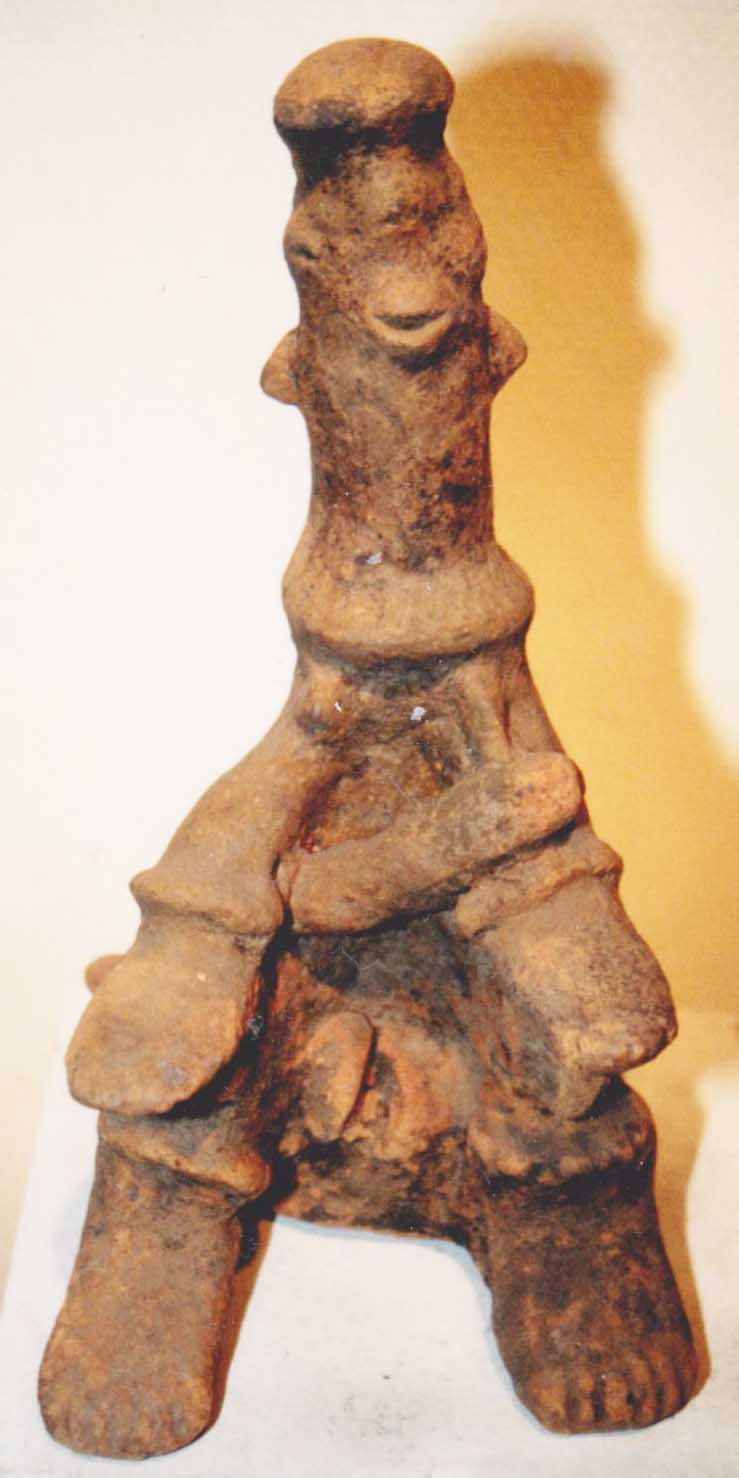 |
| Fig. 27 | Fig. 28 | Fig. 29 |
In some respects the mother and child figurines resemble the somehow standardized representations of this genre in other West African cultures: The slanting body of the baby rests on its mother’s left arm or hand while one arm sometimes touches the mother’s breast.
On at least one figure, the baby is tied to its mother’s body by strips of an unknown material (Fig. 24). The mothers wear wristlets and leglets but no hanging necklaces. Rather, the necklaces are replaced by rigid neck rings. The babies’ wristlets may have magical meanings.
The mother figurines show features which are found in other anthropomorphic Komaland figures only rarely or not at all. Their heads often have the shapes of cylinders that are rounded at their tops. While in other categories of representation female figures usually wear square waist aprons, some of the mothers display wide-open vaginas (Fig. 29). It may be speculated that these, as well as the open, bowl-like hands of some mothers, served as receptacles for sacrifices, thus taking the place of the open mouths and hollow skulls.
Janus Figurines
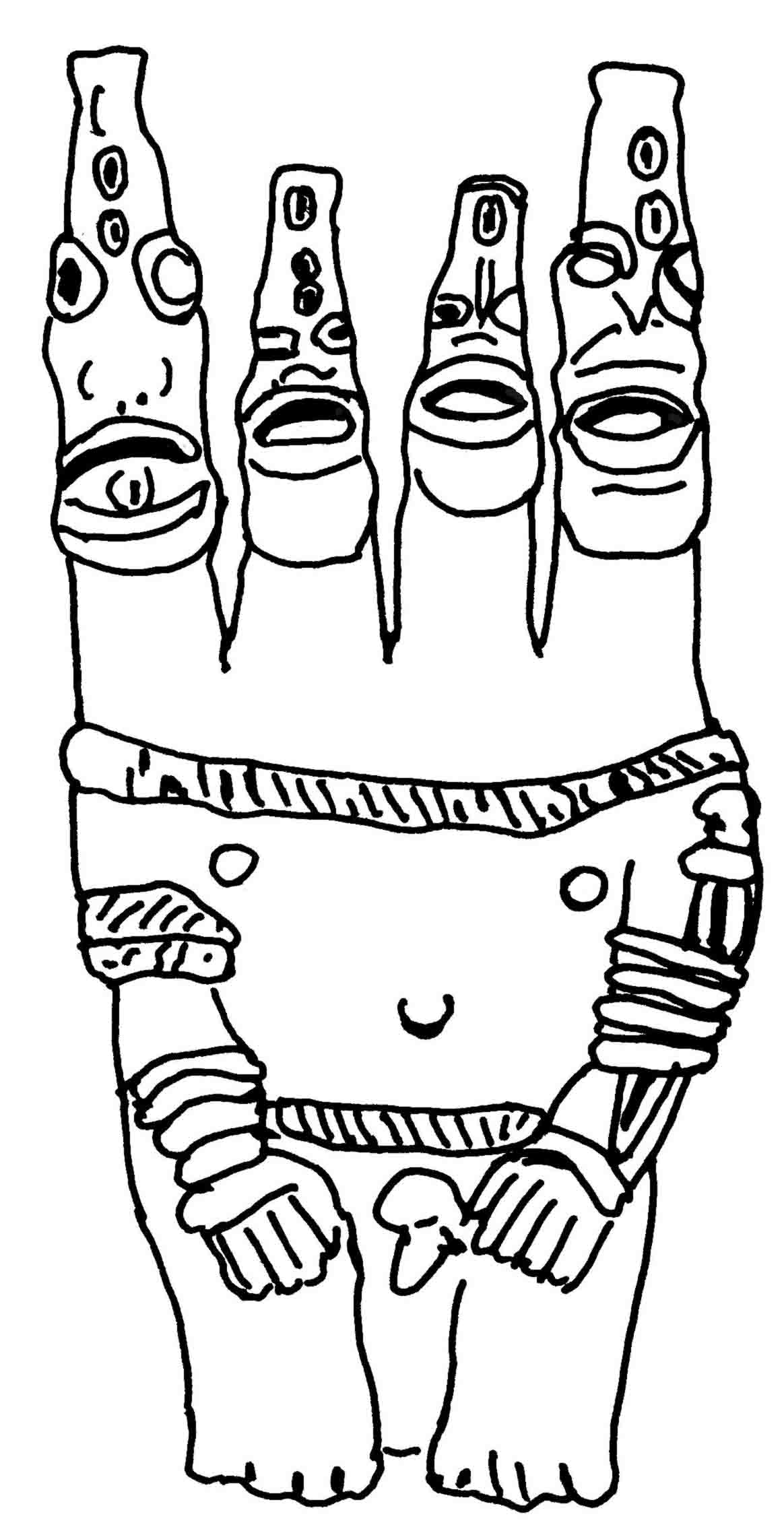 |
|
Fig. 30 |
Figures with multiple faces, heads or bodies – all called “Janus figures” here – can be found among various peoples of West Africa (e.g. among the Lobi, Dogon and Gan). It is appropriate to classify the different types of janiform figures by the number of mouths they exhibit. While only a small number of them have four faces with a total of four mouths and usually four or, in exceptional cases, eight eyes, the majority possesses two faces with two mouths and two or four eyes. On the two-eyed janiform figures, one eye and one ear each are part of two different faces. The overwhelming majority of the Janus figurines have triangular heads. As mentioned before, the particular shapes may be interpreted as snakes’ heads, as this form appears in similar Gan sculptures. Moreover, the triangular form, together with a columnar trunk, may be construed as a phallic symbol. Quite a lot of figurines have two, three or four heads. In contrast to most of the other West African figures with multiple heads, each of the Komaland heads has two faces, each looking into different directions.
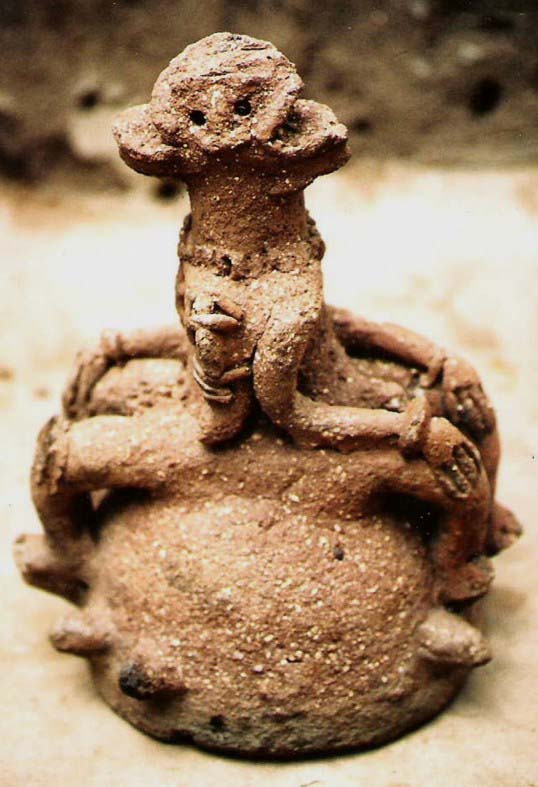 |
|
Fig. 31. Janus sitting on a lid |
Janiform Discs
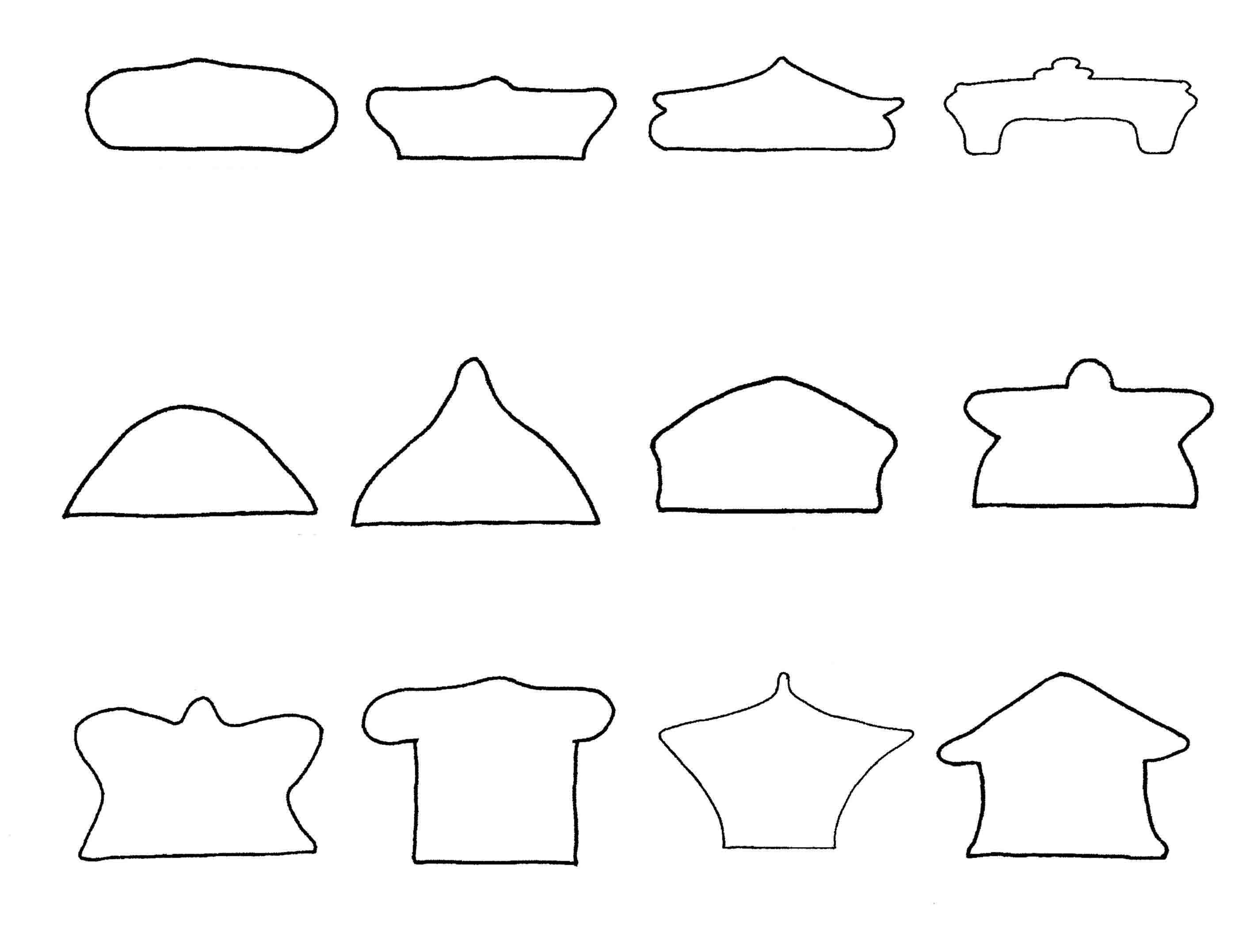 |
|
Fig. 32. Cross-section of janiform "discs" |
Circular, usually flat objects with Janus reliefs on a horizontal plane have been called janiform disks here, although some of them have a considerable height (Fig. 30). In spite of some common structural elements, there are numerous variations in the pictorial representations of the disks, as shown in the Plates I and II. Most disks have either two faces with two mouths or four faces with four mouths. The latter have four, eight or no eyes. Like the other Janus figurines, the disks might have had a religious meaning and were perhaps used as shrines.
In the figurines and disks, nearly all possibilities of janiform variations and their combinations concerning the number and positions of eyes, mouths, heads, etc. were realized. In creating these terracottas, the unusual placement of parts of the body or faces has outdone modern Western art. The eyes, for example, may be placed where ears are expected and the auricle is positioned under the eyes. Sometimes the observer has difficulty recognizing faces and their parts, but the creators produced the figurines for supernatural beings, and their understanding of distorted and displaced representations is regarded as extremely high.
An extraordinary phenomenon consists of body parts adopting a second function or meaning. Certain relief-bands with incised decorations radiating from the centre of a disk may – as is the case with non-janiform figures – represent tufts or braids of hair, but they also possess hands with fingers at their ends, thus making them arms. A hand that seems to emerge out of an ear may transform the auricle into the representation of a wrist-bangle. The Komaland artist was probably free to experiment with the structure of disks and parts of them.
Horse and Rider
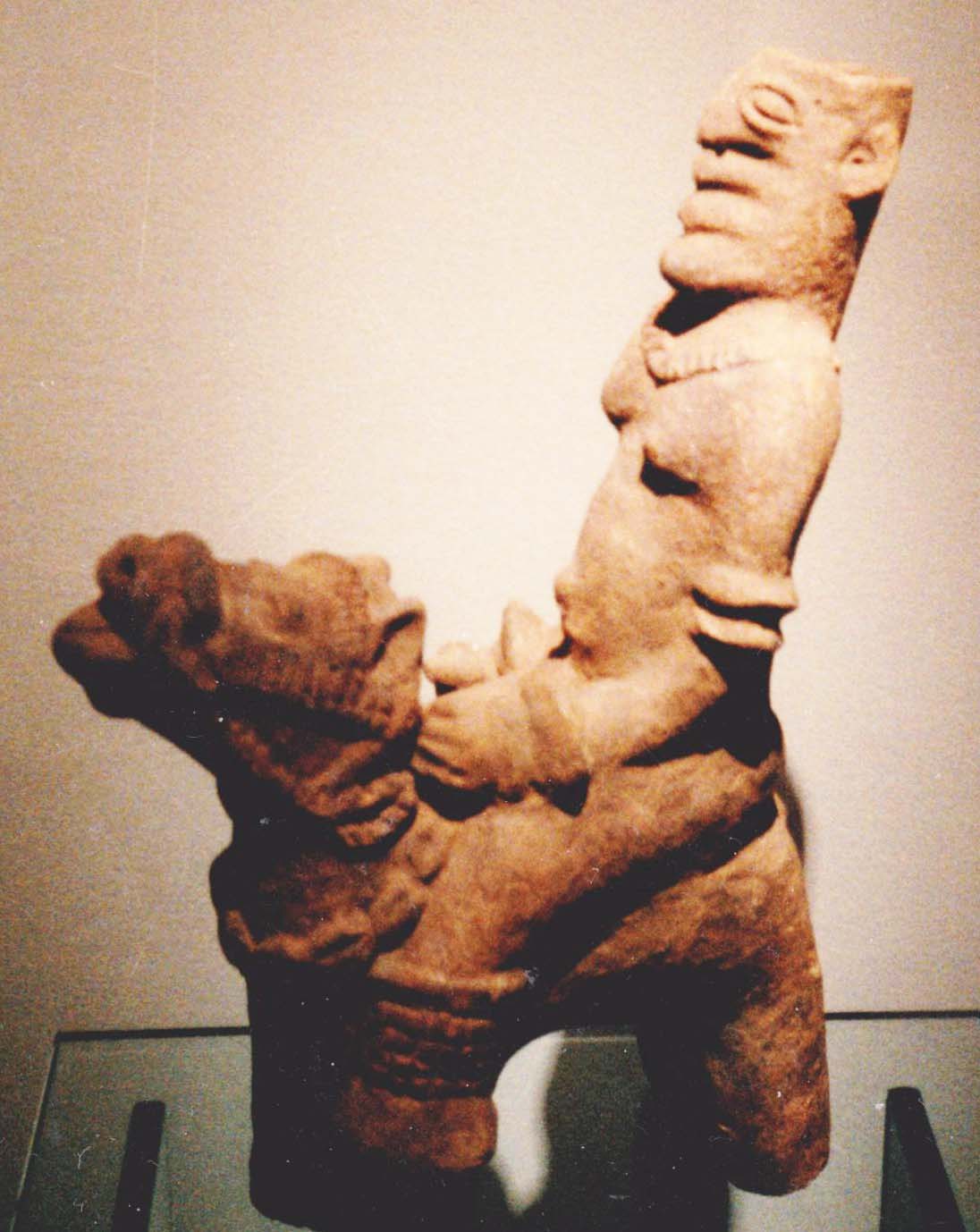 |
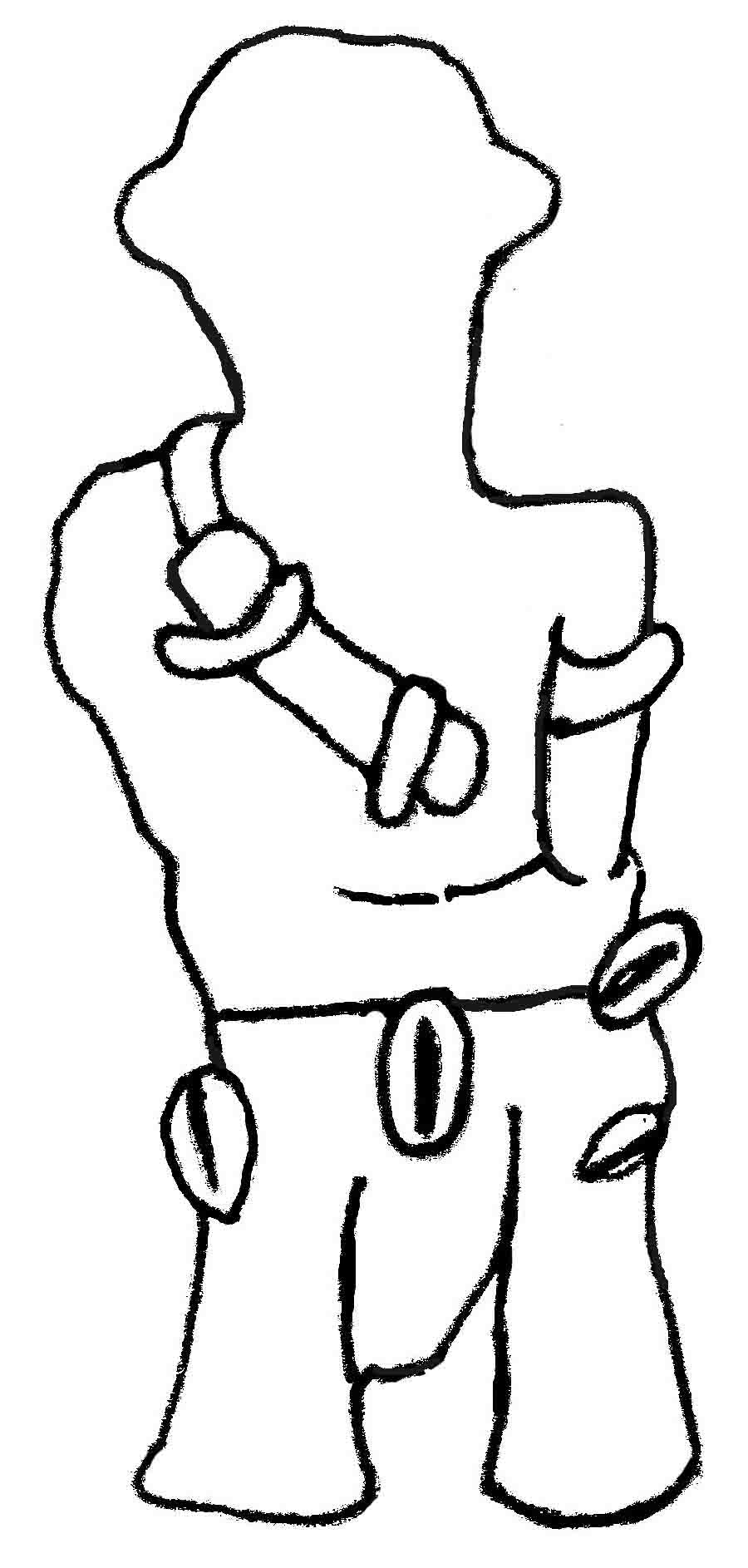 |
| Fig. 33 | Fig. 34 |
The horse is not indigenous to Africa but was imported from Asia. Although we do not know when exactly and on which way these animals came to West Africa, it is quite certain that they were introduced from northern Africa. In the 12th - 14th centuries, representations of horses and horsemen were favourite subjects of the old terracottas of the Niger-Inland-Delta.
The earliest horses introduced into West Africa were small and were ridden without a stirrup, saddle and probably without a bit or a curb. They had only a single bridle. It is this type of horse and harness that is depicted in the Komaland terracottas. Other particularities of them include: a short, cropped tail and a particular hump on their heads (Fig. 42-47).
Typical characteristics of the Komaland horsemen are metal cuffs without a protruding tong. Furthermore, ample use of decorations in cowries or metal and, occasionally, weapons (e.g. arm daggers and quivers, Fig. 34) make us believe that the riders belonged to wealthy and/or noble families.
 |
|
Fig. 35-40 |
Animals
Animal figures, which account for about 5% of all Komaland terracottas, are difficult to define, not only in terms of their function and meaning but also in terms of their assignment to a particular animal species. It is, however, quite certain that birds, snakes, crocodiles and long-legged quadrupeds, probably mammals, were depicted.
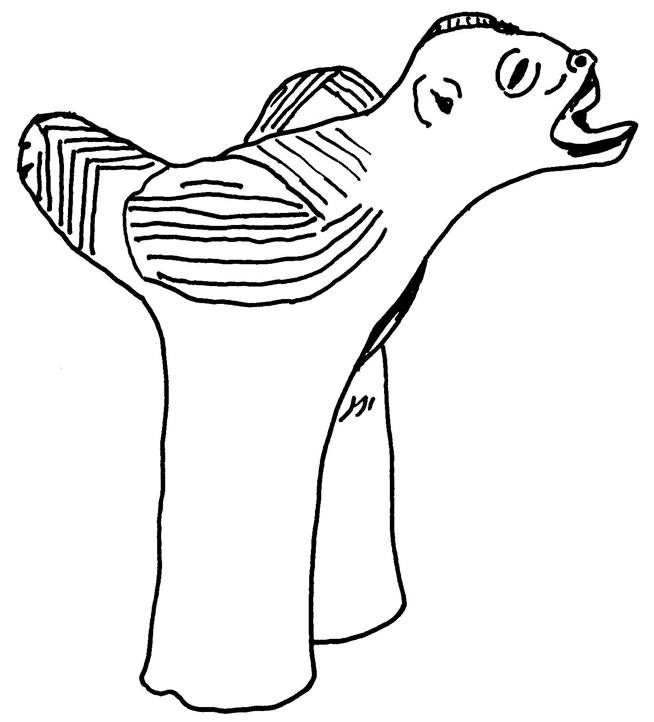 |
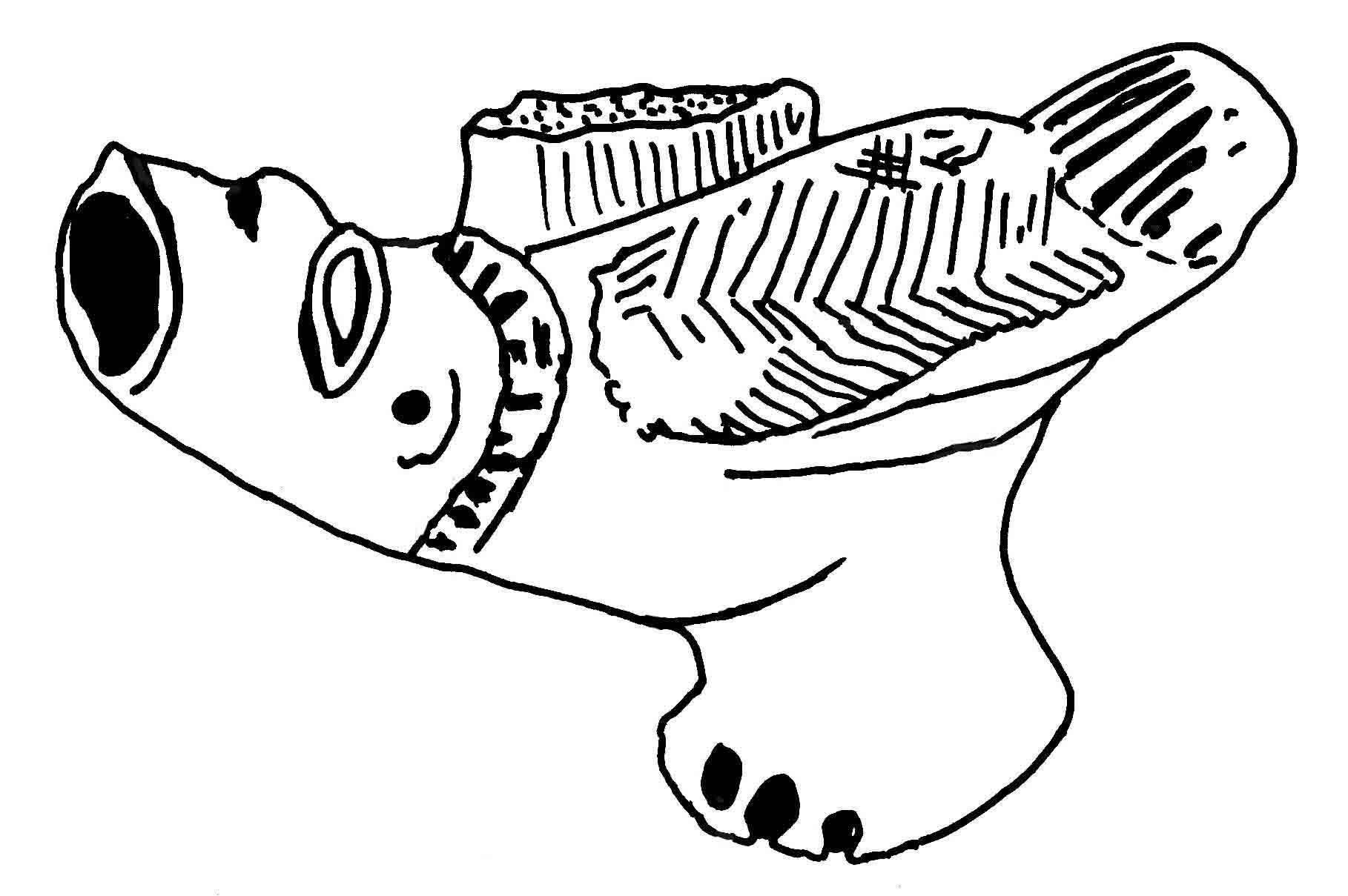 |
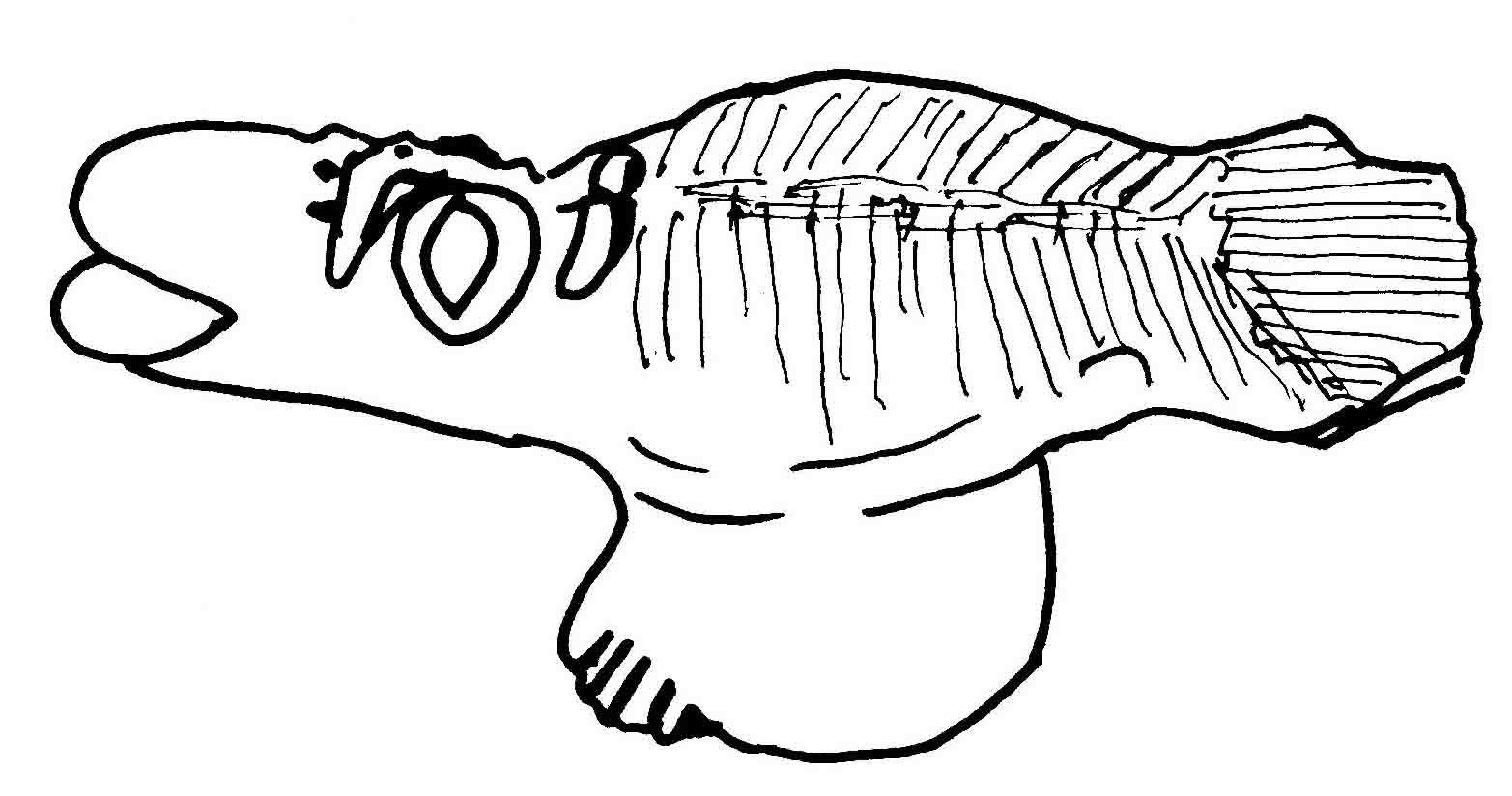 |
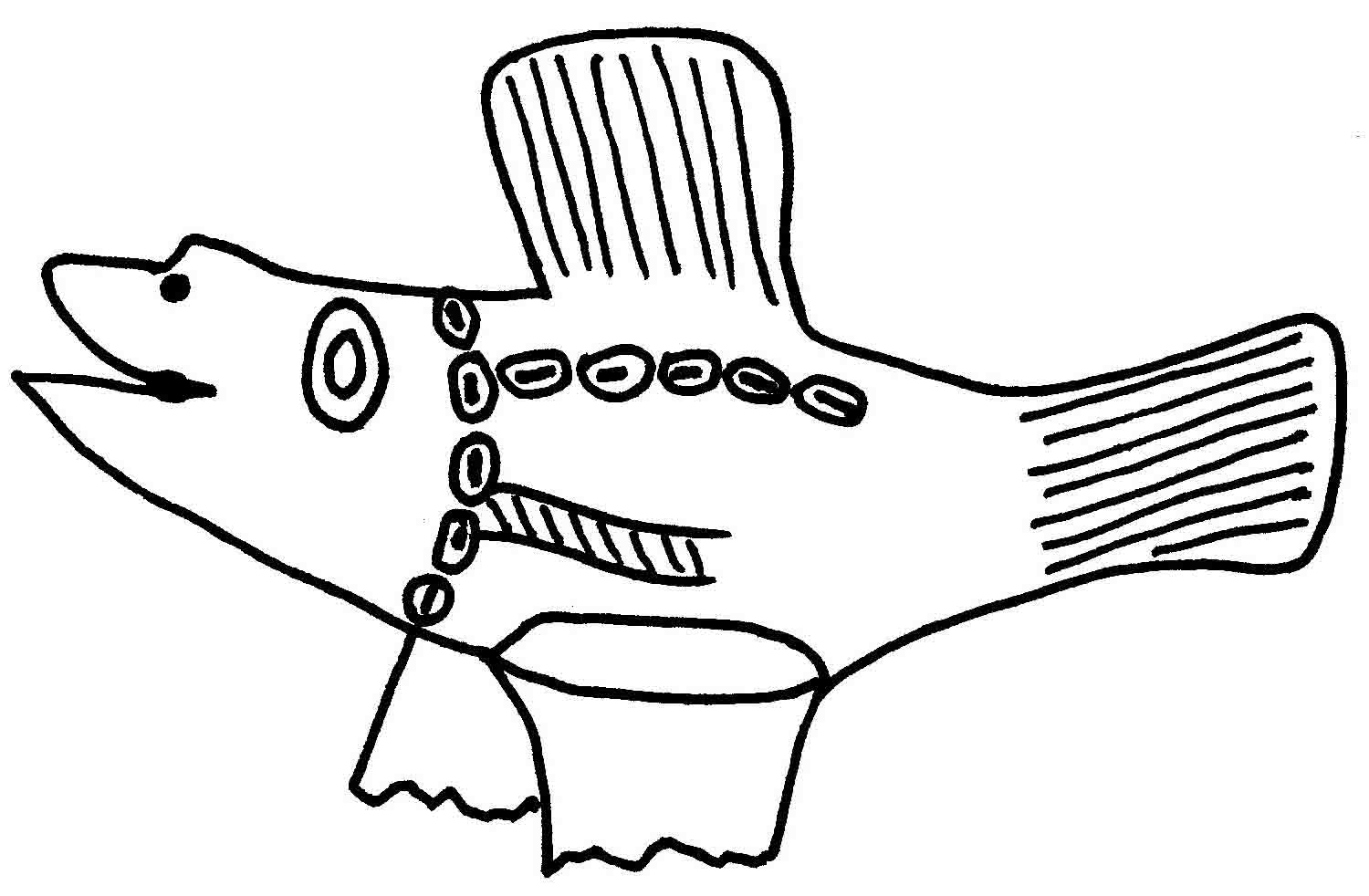 |
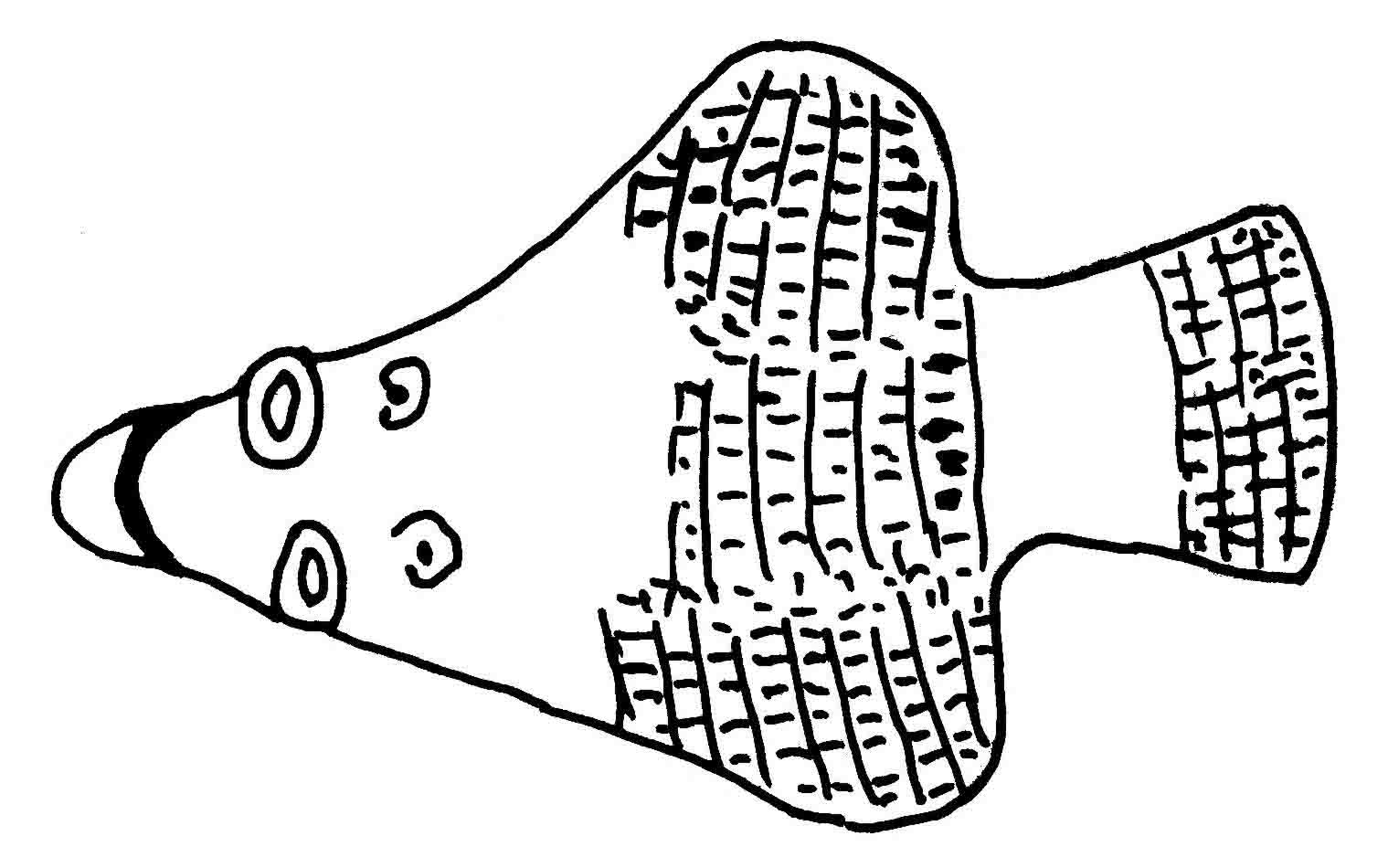 |
| Fig. 41 | Fig. 42 | Fig. 43 | Fig. 44 | Fig. 45 |
Birds can be recognized by their open wing position, their bipedalism and the hatching of the
wings and sometimes of the trunk as well. No bird has a beak, but their upraised, open mouths
make them look very human (Fig. 48-52).
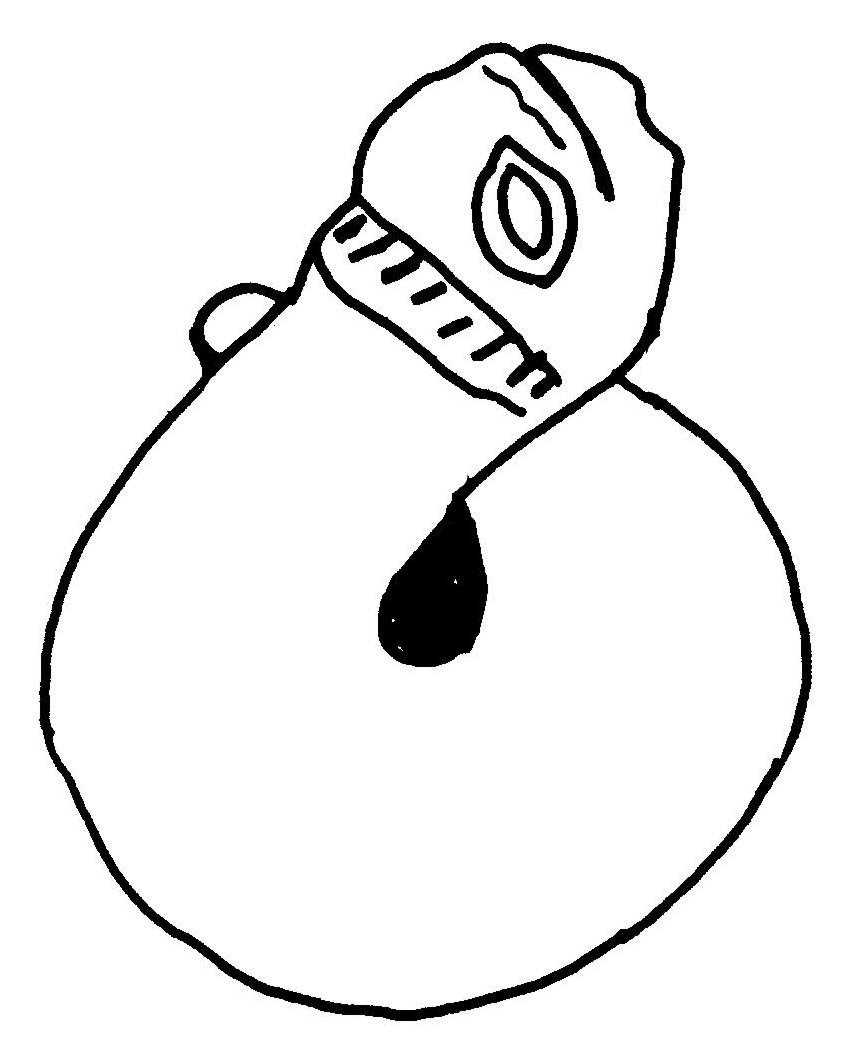 |
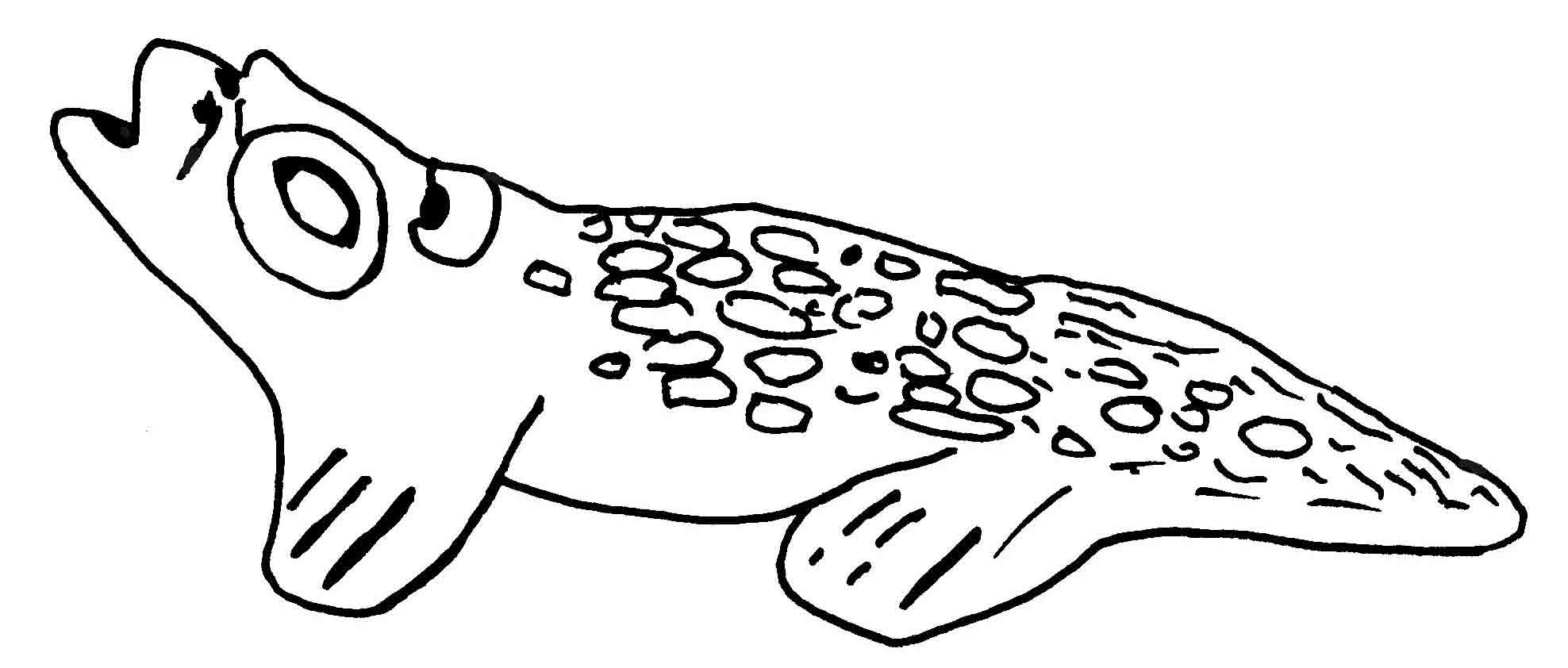 |
| Fig. 46 | Fig. 47 |
Most snakes are very short and rolled up in only one coil. Their open-mouthed heads are facing up (Fig. 46).
Crocodiles in a lying position are easy to recognize (Fig. 47). The figures of this group are
characterized by their longish shape and by the elaborate decorations on their backs.
Animals with four long legs are interpreted here as mammals. Some of them have round
human heads (Fig. 48). The representation of collars and leads may infer the domestication of the
species depicted here (Fig. 49-50).
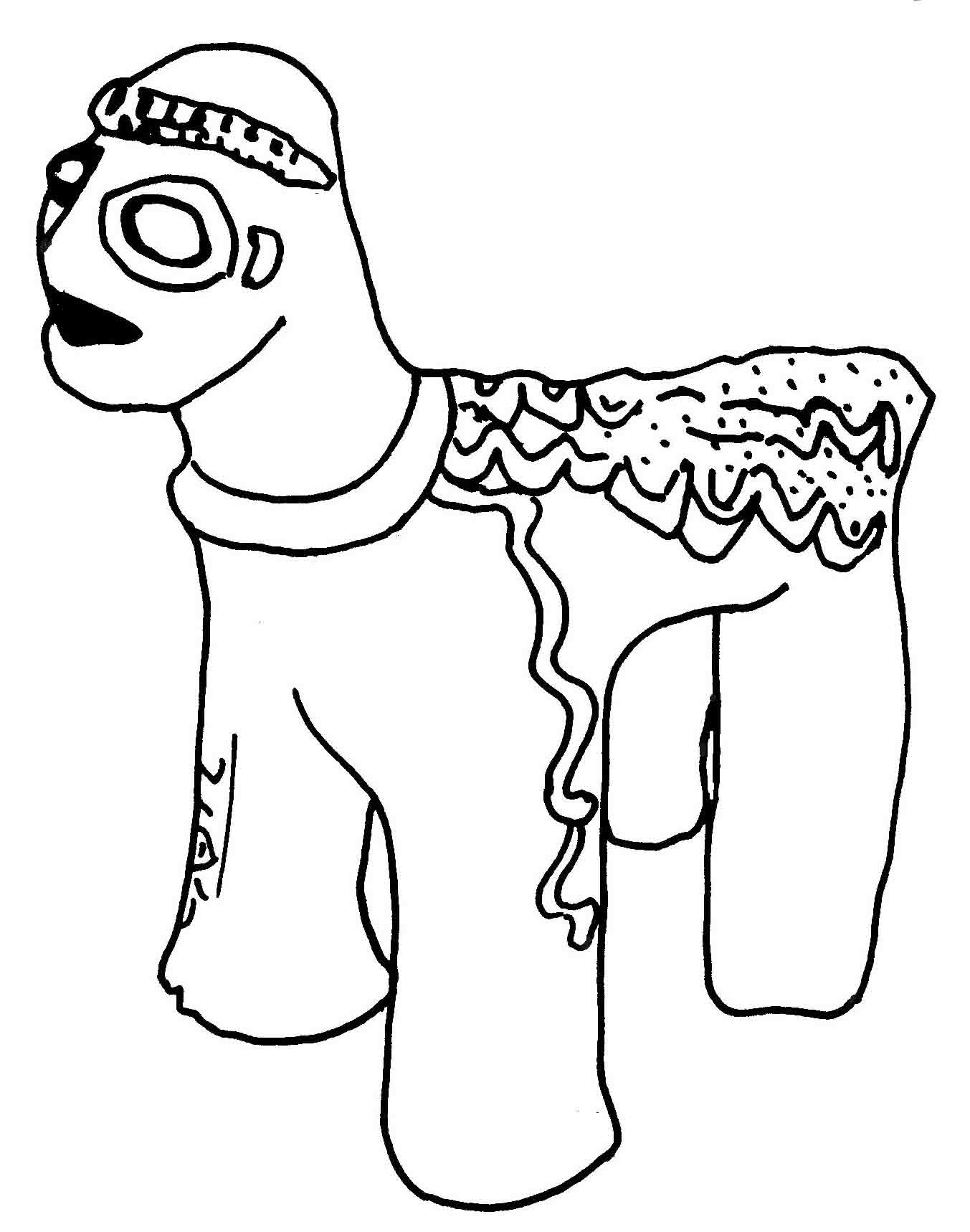 |
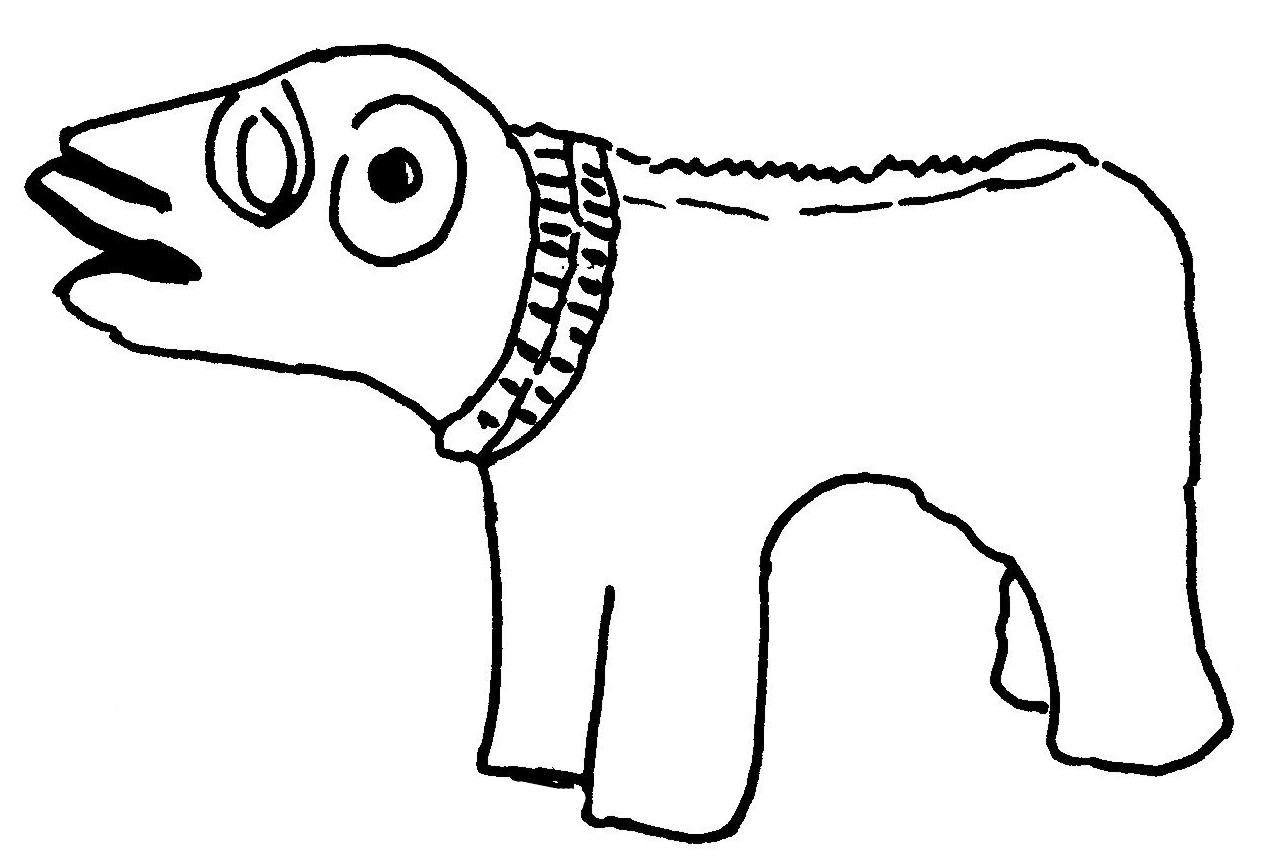 |
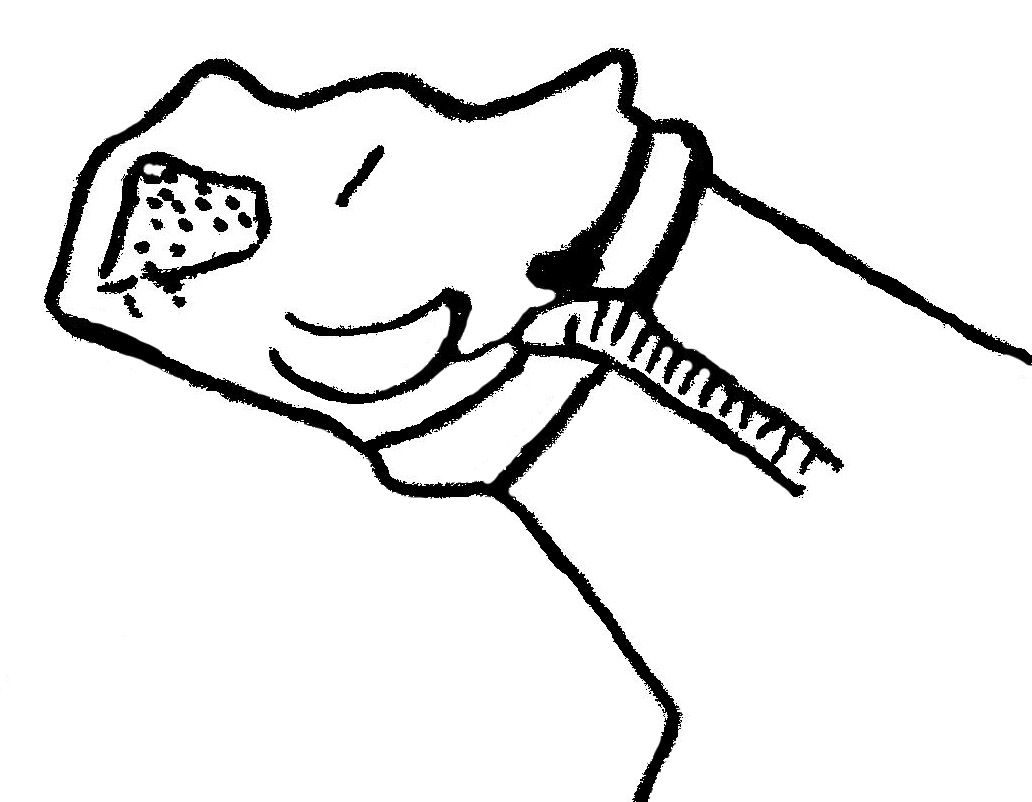 |
| Fig. 48 | Fig. 49 | Fig. 50 |
Although it is also very probable that the animal figurines received sacrifices in their open mouths, their specific religious function cannot be deduced. Several authors associate them with the ancestor cult.
Hairstyles and Beards (Plate II and IV)
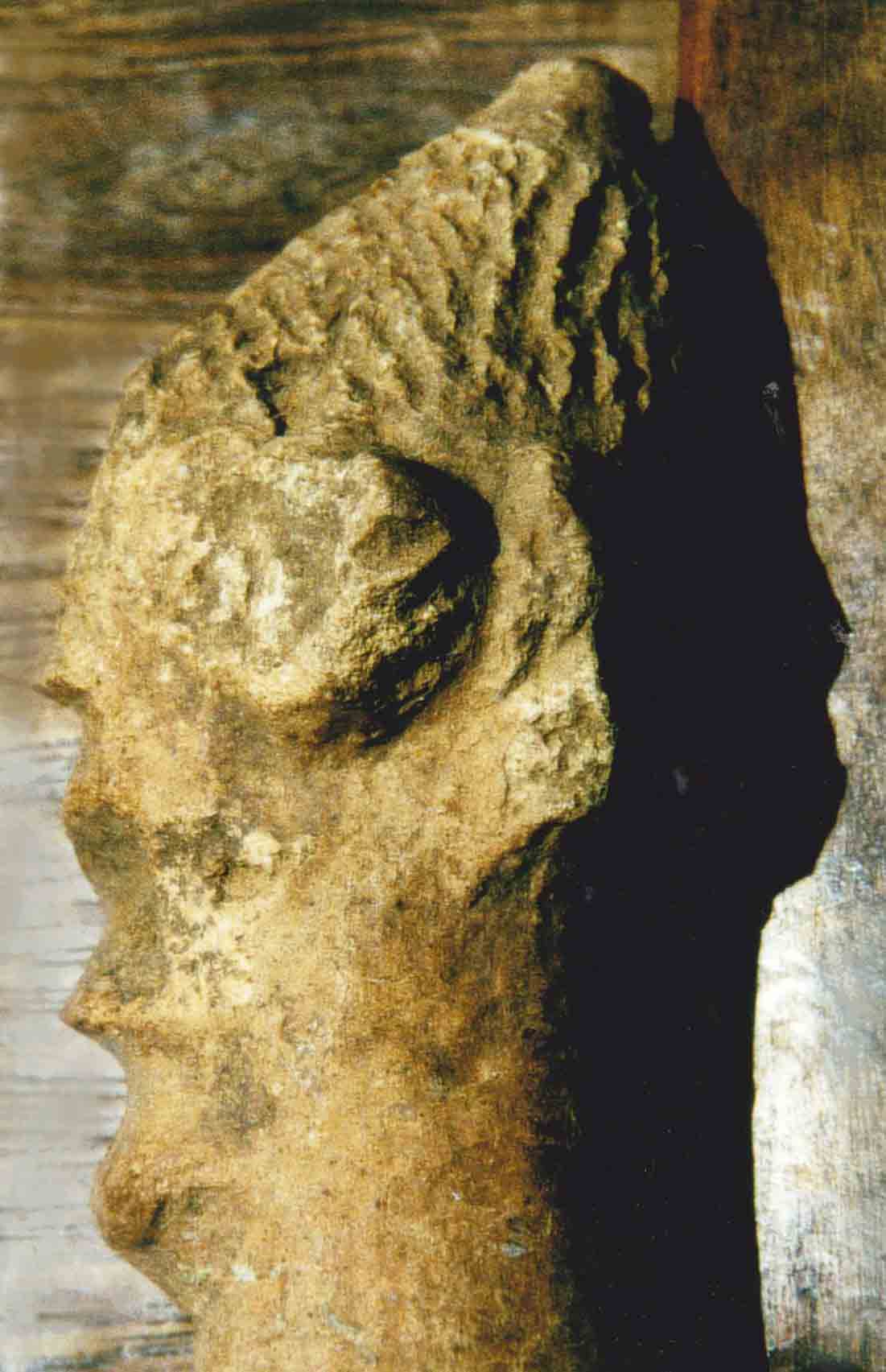 |
|
Fig. 51 |
A band across the forehead, sometimes surrounding the whole head or falling down to the cheeks or the beard into which they may merge, is one of the most common elements adorning the head. Both the original material as well as the function of these “headbands” are uncertain, but as they resemble the representations of beards, they may depict hair.
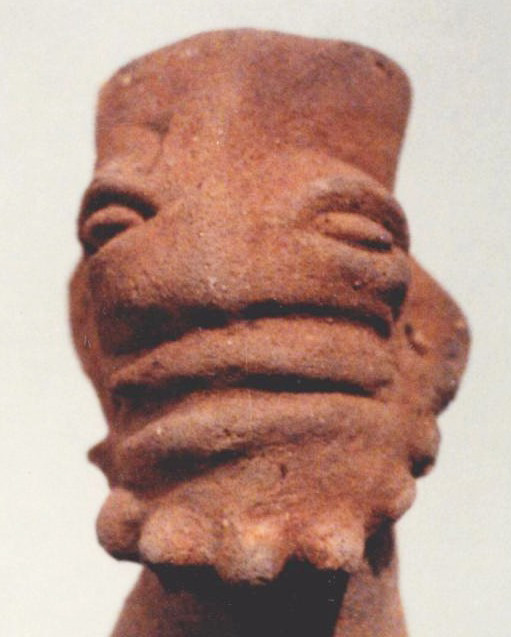 |
|
Fig. 52 |
Sagittal hair crests, limited to women in some West African societies, are usually found on male terracotta figurines. They consist of 1-3 rows and may combine with braids and cowry adornment. The headskin on either side of them was probably shaved.
Other hairstyles prove that the creators of the terracottas, like West African women today, made use of an immense repertoire for dressing their hair by applying different methods, including plaiting, adding other materials or shaving.
Furthermore, the number of different beard styles was apparently very large, too (Plate IV). Most beards are pointed and have vertical incisions or rectangular or hatched patterns. Often they consist of vertical braids or round tufts of hair.
Hats and Caps (Plate IV)
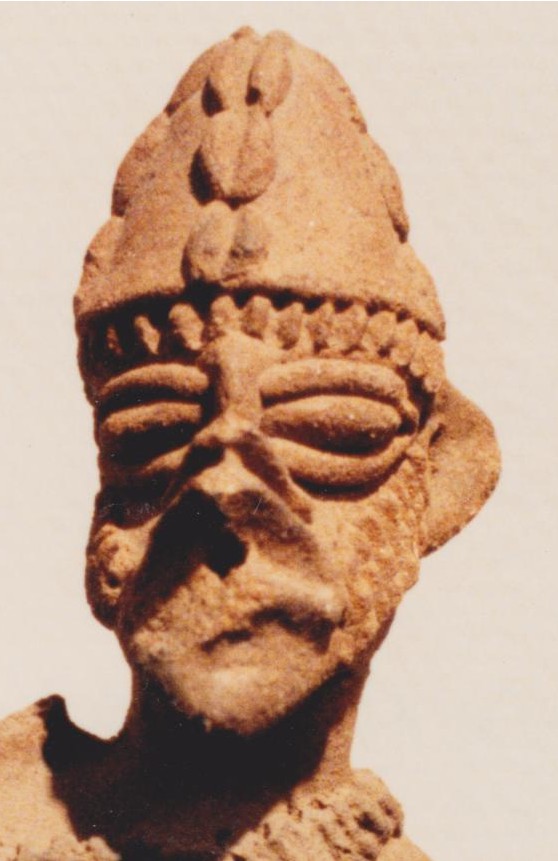 |
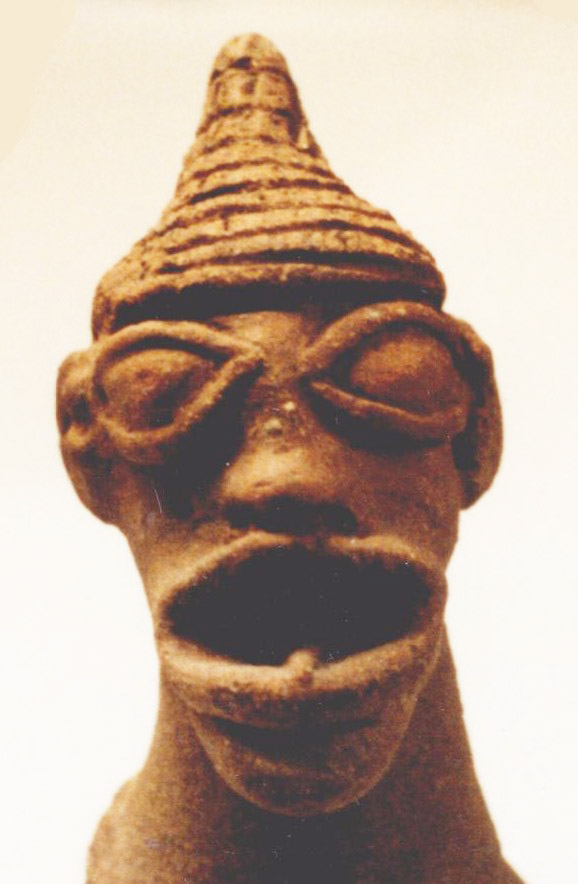 |
| Fig. 53 | Fig. 54 |
It is quite certain that the calabash hat or helmet, sometimes adorned with a crest or cowry shells, was a common form of headgear. The occurrence of the Phrygian cap, today typical of traditional cloth costumes of Northern Ghana, is definitely not found on the terracottas. On the other hand, pointed hats, which are not worn in the region today, appear on many figurines. The questions of the material of these hats must again remain unanswered. There was no recognizable gender-based assignment of hats.
Necklaces (Plate V)
The superabundant decoration of the anthropomorphic figurines suggests the depicted persons were part of a wealthy or noble class. It is, however, not evident if their outfit mirrors the status of living persons or ancestors.
Flat necklaces in single, double or triple rows have designs indicating perhaps plaited or twisted bands.
Pendants and Amulets (Plate V and VI)
Annular or disk-shaped pendants with a knobs or cowries in their centres are very common among the terracotta figurines, especially among male dignitaries and horsemen. A bronze disk is said to have been excavated in the Koma area. If it is really an object of the Komaland culture, it supports the theory that much body adornment was made of bronze.
Longish horizontal or vertical objects worn as pendants, perhaps depicting pieces of roots, certainly had a magical meaning. While protective or healing amulets are usually worn without any container on a neck or waist string, powdered substances are kept in animal horns. In present-day Northern Ghana, their openings are closed with calabash or potsherds. Many round potsherds, interpreted as lids of such horns, were found in Yikpabongo excavations. Komaland figurines often wear two of these horns around their necks or, more rarely, on waist strings.
Moon-amulets made of iron or bronze are very common in Northern Ghana and other parts of West Africa. Among the Komaland figurines, we also find moon amulets in combination with longish objects as described above, thus creating other forms of amulets, for example in the shape of a flute (Fig. 63).
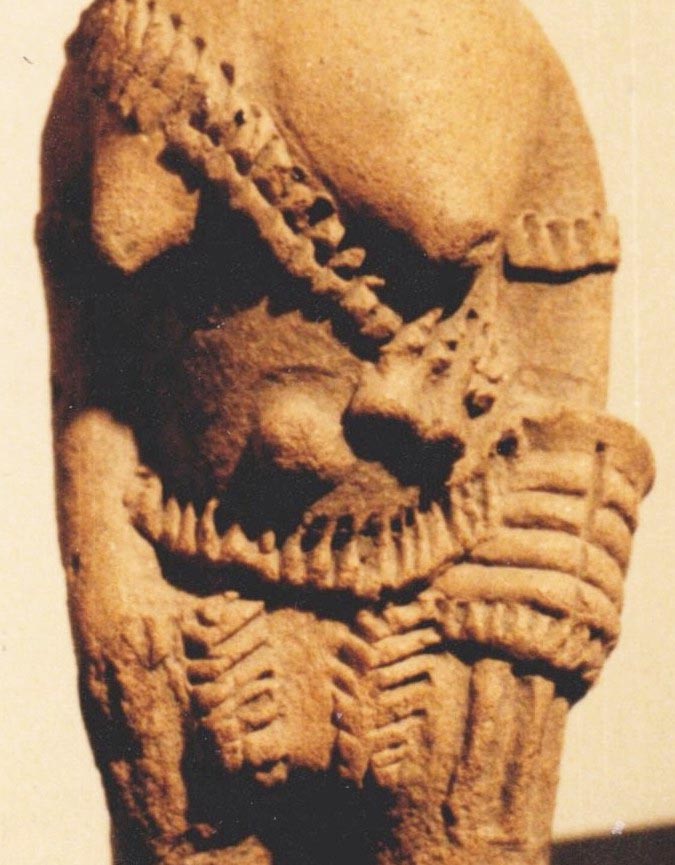 |
|
Fig. 56 |
Armlets and Leglets (Plate VI)
Apart from decorative and magical purposes, armlets and leglets might also have had a practical function. An arm ring, for example, might impart more force to a thrown spear or a brandished club. Closed rings with a D-shaped cross-section might have consisted of black marble mined in the Hombori Mountains of Mali, as has been the case up until even quite recent times in Northern Ghana. Some women wear cuff-like wristlets, as they are more common on the legs of mounted Komaland warriors.
Bangles on the right and left legs display a stricter symmetry than right and left arm rings.
Arm Daggers (Plate VII)
Although the people of the Komaland culture were certainly familiar with different types of weapons, the arm dagger is the only attack weapon clearly identifiable on many male figurines, especially on horsemen. In a fight it could be easily drawn from its attachment to the left upper arm using the right hand. Hahn (1981:391) has pointed out that the Bassari of Togo used their arm daggers as weapons but also occasionally for dressing a hunted animal, cutting leather or woodcarving.
The angle between the handle and blade of the daggers is between 140̊ and 170̊, and on the terracottas their tips sometimes reach the back of the left hand. The handle and its final knob appear in different shapes as shown in Fig. 65.
While on the sculptures found in the Niger-Inland-Delta and among the Dogon the arm dagger is probably fixed to the upper arm by straps, the daggers’ blades on the Komaland terracottas are fastened with 2-7 upper arm bangles.
Unlike most of the other material elements of the figurines, the arm dagger is only used by a limited number of West African ethnic groups, and they do not live in the immediate vicinity of the terracotta finds. Lagercrantz (1950: 214) suggests a spread, which had its starting point inside the Sudan, probably in the Chad region. According to his distribution map (1937: 426), the excavation sites of the Komaland terracottas are situated in the Western part of the distribution area. Salaga, the old commercial centre, is mapped as the closest place to Yikpabongo. It has been pointed out (Kröger 1988: 140) that before the arrival of the British, a trade route from the north via Kanjaga and Wiesi in Bulsaland through the present Koma area led to Daboya and from there to Salaga. Along this trade route, objects of material culture could have also made their way to Komaland.
 |
|
Fig. 57. Various knobs of forearm daggers |
Things on Shoulders (Plate VII)
In West Africa heavy loads are usually worn on the head, but lighter items like hoes, axes or animal skins are slung over the left shoulder. Several Komaland figurines are depicted wearing a flexible object over the left shoulder, and this object looks like an animal skin in some figurines. It is likely that the pouch of a rotation sling is depicted here. In one figurine the rope of the sling can be recognized (Fig. 66-68). Today slings are mainly used for driving birds from millet fields. In earlier times, however, they also served as weapons among several West African peoples.
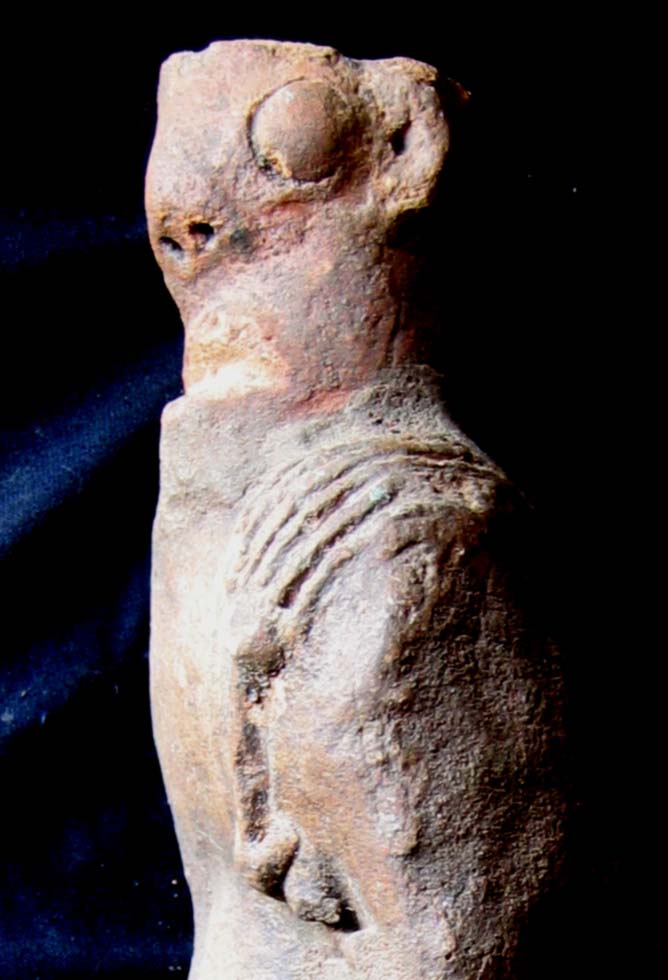 |
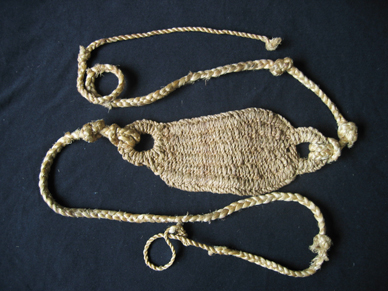 |
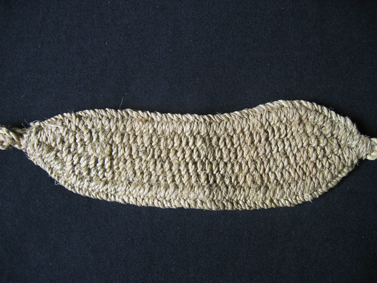 |
| Fig. 58. Komaland terracotta | Fig. 59 and 60. Modern sling of the Bulsa | |
Sexual Organs and Pubic Aprons (Plate VIII)
Apart from pubic aprons and hats, all anthropomorphic Komaland figurines are nude. Nevertheless it is sometimes difficult to determine their sex.
Quite clearly beards identify their wearers as male, while the occurrence of breasts is less
reliable for the purpose of gender assignment. In many bearded figurines, the breasts are
almost of the same shape as those depicted on the female figurines. Nevertheless, it would be
premature to regard them as hermaphroditic representations because in other West African
sculptures, for example of the Lobi and Dogon, the male breast has elaborately been fleshed
out without the implication of hermaphroditism.
The male figurines usually have a more or less distinctly moulded phallus with or without
testicles. According to Insoll et al. (2013: 33) the occurrence of a phallus is typical of
terracottas from Tando-Fagusa, while the excavated figures of Yikpabongo have no or only
very stylized genitalia. Usually the phallus is presented as a cylindrical organ tapering
downwards. The lack of circumcision may be concluded from its pointed shape, but in at least
one figurine, the naked glans penis of a non-erect phallus can be recognized (Plate VIII,9).
Sometimes the waist string lies over a portion of the phallus in the same way as depicted in
Rattray’s photos of two young Lobi men (1932: 446, Fig. 115-116).
The abdomen of female figurines is represented relatively uniformly. Apart from some circular or semi-circular pubic aprons and the completely bare vagina in representations of the mothers, the genital organs are covered by a rectangular or almost square pubic apron). Its vertical, often irregular incisions and grooves suggest that it was made from plant fibres, grasses or the like. Sometimes braided bands or strings of cowries of equal length with the fibres frame the apron on both sides.
Ceramic vessels (Plate IX)
Terracotta figurines are easy to recognize as such because of their many stylistic characteristics. The ceramic vessels minus any applications, however, resemble those of other cultures very much. Nevertheless, in some Komaland vessels there are typical features such as the use of feet and flat knobs as handles. The vessels were certainly not wheelthrown but moulded in the coiling technique.
Conclusion
Although little is known about the function and meaning of the Komaland terracottas, they impress lovers of African art with their perfect craftsmanship and their display of free artistic creativity. This approach by art lovers, which emphasizes mainly aesthetic aspects of the figurines, is sometimes seen as suspect by anthropologists, archaeologists or historians. They are critical of the fact that in exhibitions ethnographic objects, presented in effective artificial light, are often removed from their cultural context and that information about the function and meaning is frequently neglected.
On the other hand, it also seems overblown when students of ethnology and archaeology are advised by their mentors to avoid the term “art” and statements about the artistic value of an object in the description and analysis of material culture completely.
The Komaland terracottas were probably produced for a religious purpose and represented supernatural entities. Most of them served as sacrificial shrines. For this purpose, a simple, artless presentation of an offering bowl would have been enough. Creating figurines equipped with objects of everyday life and rich jewellery did not only serve a particular function. The creator also wanted to produce an aesthetically beautiful and expressive object.
Very little is known today about the cultural environment of the Komaland terracottas. Therefore, in the description and interpretation of artefacts, it is difficult to decide which forms and material elements of the figures should be interpreted as artistic expression or realistic representations of everyday objects. All interpretations are still of a highly speculative nature. Nevertheless, the sometimes more than 800 year-old terracottas provide a glimpse into Africa’s past, and it is possible to draw relevant conclusions from inconspicuous equipment on the figurines’ bodies.
In the scientific discourse between an aestheticizing and a purely scientific approach to ethnographic objects, both prove useful for the treatment of Komaland terracottas. On one hand, it appears valid and necessary to illustrate and appreciate their high artistic value. On the other hand, this text has focused on ways to give the art lover a better understanding of the admired objects. Moreover, it may provide the active archaeologist with new hypotheses that can be falsified or verified by further excavation results and by new datings and analyses of excavated artefacts.